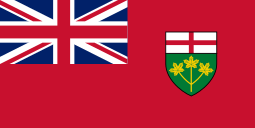Toronto Maple Leafs
The Toronto Maple Leafs, officially the Toronto Maple Leaf Hockey Club and often simply referred to as the Leafs, are a professional ice hockey team based in Toronto. They compete in the National Hockey League (NHL) as a member of the Atlantic Division of the Eastern Conference. The club is owned by Maple Leaf Sports & Entertainment, Ltd. and are represented by Chairman Larry Tanenbaum. The Maple Leafs' broadcasting rights are split between BCE Inc. and Rogers Communications.[3] For their first 14 seasons, the club played their home games at the Mutual Street Arena, before moving to Maple Leaf Gardens in 1931. The Maple Leafs moved to their present home, Scotiabank Arena (originally named Air Canada Centre) in February 1999.
| Toronto Maple Leafs | |
|---|---|
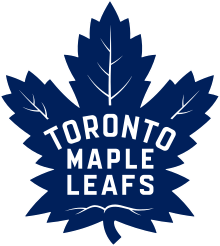 | |
| Conference | Eastern |
| Division | Atlantic |
| Founded | 1917 |
| History | Toronto Arenas 1917–1919 Toronto St. Patricks 1919–1927 Toronto Maple Leafs 1927–present |
| Home arena | Scotiabank Arena |
| City | Toronto, Ontario |
| Colours | Navy blue, white[1][2] |
| Media | Leafs Nation Network Sportsnet Ontario TSN4 Sportsnet 590 The Fan TSN Radio 1050 |
| Owner(s) | Maple Leaf Sports & Entertainment Ltd. (Larry Tanenbaum, chairman) |
| General manager | Kyle Dubas |
| Head coach | Sheldon Keefe |
| Captain | John Tavares |
| Minor league affiliates | Toronto Marlies (AHL) Newfoundland Growlers (ECHL) |
| Stanley Cups | 13 (1917–18, 1921–22, 1931–32, 1941–42, 1944–45, 1946–47, 1947–48, 1948–49, 1950–51, 1961–62, 1962–63, 1963–64, 1966–67) |
| Conference championships | 0 |
| Presidents' Trophy | 0[note 1] |
| Division championships | 5 (1932–33, 1933–34, 1934–35, 1937–38, 1999–2000) |
| Official website | www |
The club was founded in 1917, operating simply as Toronto and known then as the Toronto Arenas. Under new ownership, the club was renamed the Toronto St. Patricks in 1919. In 1927, the club was purchased by Conn Smythe and renamed the Maple Leafs. A member of the "Original Six", the club was one of six NHL teams to have endured through the period of League retrenchment during the Great Depression. The club has won thirteen Stanley Cup championships, second only to the 24 championships of the Montreal Canadiens. The Maple Leafs history includes two recognized dynasties, from 1947 to 1951; and from 1962 to 1967.[4][5] Winning their last championship in 1967, the Maple Leafs' 51-season drought between championships is the longest current drought in the NHL. The Maple Leafs have developed rivalries with four NHL franchises: the Boston Bruins, Detroit Red Wings, the Montreal Canadiens, and the Ottawa Senators.
The Maple Leafs have retired the use of thirteen numbers in honour of nineteen players, including the first in professional sports. In addition, a number of individuals who hold an association with the club have been inducted in the Hockey Hall of Fame. The Maple Leafs are presently affiliated with two minor league teams, the Toronto Marlies of the American Hockey League, and the Newfoundland Growlers of the ECHL.
Team history
| Evolution of the Toronto Maple Leafs |
|---|
| Teams |
| Toronto Pro HC (ind., OPHL) 1906–1909 |
| Toronto Blueshirts (NHA) 1912–1917 |
| Toronto Arenas (NHL) 1917–1919 |
| Toronto St. Patricks (NHL) 1919–1927 |
| Toronto Maple Leafs (NHL) 1927–present |
| Ice hockey portal |
Early years (1917–1927)
The National Hockey League was formed in 1917 in Montreal by teams formerly belonging to the National Hockey Association (NHA) that had a dispute with Eddie Livingstone, owner of the Toronto Blueshirts. The owners of the other four clubs — the Montreal Canadiens, Montreal Wanderers, Quebec Bulldogs and the Ottawa Senators — wanted to replace Livingstone, but discovered that the NHA constitution did not allow them to simply vote him out of the league.[6] Instead, they opted to create a new league, the NHL, and did not invite Livingstone to join them. They also remained voting members of the NHA, and thus had enough votes to suspend the other league's operations, effectively leaving Livingstone's league with one team.[7]
The NHL had decided that it would operate a four-team circuit, made up of the Canadiens, Maroons, Ottawa, and one more club in either Quebec or Toronto. Toronto's inclusion in the NHL's inaugural season was formally announced on November 26, 1917, with concerns over the Bulldogs' financial stability surfacing.[8] The League granted temporary franchise rights to the Arena Company, owners of the Arena Gardens.[9] The NHL granted the Arena responsibility of the Toronto franchise for only the inaugural season, with specific instructions to resolve the dispute with Livingstone, or transfer ownership of the Toronto franchise back to the League at the end of the season.[10]
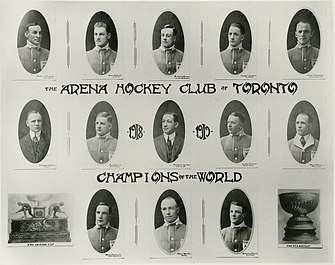
The franchise did not have an official name, but was informally called "the Blueshirts" or "the Torontos" by the fans and press.[11] Although the inaugural roster was made up of players leased from the NHA's Toronto Blueshirts, including Harry Cameron and Reg Noble, the Maple Leafs do not claim the Blueshirts' history as their own.[12] During the inaugural season the club performed the first trade in NHL history, sending Sammy Hebert to the Senators, in return for cash.[13] Under manager Charlie Querrie, and head coach Dick Carroll, the team won the Stanley Cup in the inaugural 1917–18 season.[14]
For the next season, rather than return the Blueshirts' players to Livingstone as originally promised, on October 19, 1918, the Arena Company formed the Toronto Arena Hockey Club, which was readily granted full membership in the NHL.[15] The Arena Company also decided that year that only NHL teams were allowed to play at the Arena Gardens—a move which effectively killed the NHA.[16] Livingstone sued to get his players back. Mounting legal bills from the dispute forced the Arenas to sell some of their stars, resulting in a horrendous five-win season in 1918–19. With the company facing increasing financial difficulties, and the Arenas officially eliminated from the playoffs, the NHL agreed to let the team forfeit their last two games.[13][17] Operations halted on February 20, 1919, with the NHL ending its season and starting the playoffs. The Arenas' .278 winning percentage that season remains the worst in franchise history. However, the 1919 Stanley Cup Finals ended without a winner due to the worldwide flu epidemic.[13]
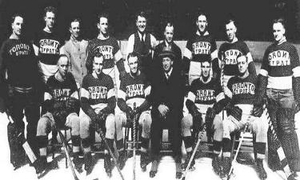
The legal dispute forced the Arena Company into bankruptcy, and it was forced to sell the team. On December 9, 1919, Querrie brokered the team's purchase by the owners of the St. Patricks Hockey Club, allowing him to maintain an ownership stake in the team.[18] The new owners renamed the team the Toronto St. Patricks (or St. Pats for short), which they used until 1927.[19] Changing the colours of the team from blue to green, the club won their second Stanley Cup championship in 1922.[17] Babe Dye scored four times in the 5–1 Stanley Cup-clinching victory against the Vancouver Millionaires.[20] In 1924 Jack Bickell invested C$25,000 in the St. Pats as a favour to his friend Querrie, who needed to financially reorganize his hockey team.[21]
Conn Smythe era (1927–1961)
After a number of financially difficult seasons, the St. Patricks' ownership group seriously considered selling the team to C. C. Pyle for C$200,000 (equivalent to $2,932,000 in 2018). Pyle sought to move the team to Philadelphia.[17][22] However, Toronto Varsity Blues coach Conn Smythe put together a group of his own and made a $160,000 (equivalent to $2,345,000 in 2018) offer. With the support of Bickell, a St. Pats shareholder, Smythe persuaded Querrie to accept their bid, arguing that civic pride was more important than money.[22]
After taking control on February 14, 1927, Smythe immediately renamed the team the Maple Leafs, after the national symbol of Canada.[23] He attributed his choice of a maple leaf for the logo to his experiences as a Canadian Army officer and prisoner of war during World War I. Viewing the maple leaf as a "badge of courage", and a reminder of home, Smythe decided to give the same name to his hockey team, in honour of the many Canadian soldiers who wore it.[17][24][25] However, the team was not the first to use the name. A Toronto minor-league baseball team had used the name "Maple Leafs" since 1895.[26]
Initial reports were that the team's colours were to be red and white,[27] but the Leafs wore white sweaters with a green maple leaf for their first game on February 17, 1927.[28] On September 27, 1927, it was announced that the Leafs had changed their colour scheme to blue and white.[29] Although Smythe later stated he chose blue because it represents the Canadian skies and white to represent snow, these colours were also used on his gravel and sand business' trucks.[29] The colour blue was also a colour historically associated with the City of Toronto. The use of blue by top-level Toronto-based sports clubs began with the Argonaut Rowing Club in the 19th century, later adopted by their football team, the Toronto Argonauts, in 1873.[30]
Opening of Maple Leaf Gardens (1930s)
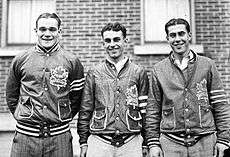
By 1930 Smythe saw the need to construct a new arena, viewing the Arena Gardens as a facility lacking modern amenities and seating.[31] Finding an adequate number of financiers, he purchased land from the Eaton family, and construction of the arena was completed in five months.[32][33]
The Maple Leafs debuted at their new arena, Maple Leaf Gardens, with a 2–1 loss to the Chicago Black Hawks on November 12, 1931.[33] The opening ceremonies for Maple Leaf Gardens included a performance from the 48th Highlanders of Canada Pipe and Drums.[34] The military band has continued to perform in every subsequent season home opening game, as well as other ceremonies conducted by the hockey club.[35][36] The debut also featured Foster Hewitt in his newly constructed press box above the ice surface, where he began his famous Hockey Night in Canada radio broadcasts that eventually came to be a Saturday-night tradition.[33] The press box was often called 'the gondola', a name that emerged during the Gardens' inaugural season, when a General Motors advertising executive remarked how it resembled the gondola of an airship.[37]
By the 1931–32 NHL season, the Maple Leafs were led by the "Kid Line" consisting of Busher Jackson, Joe Primeau and Charlie Conacher and coached by Dick Irvin. The team captured their third Stanley Cup that season, vanquishing the Chicago Black Hawks in the first round, the Montreal Maroons in the semifinals, and the New York Rangers in the finals.[38] Smythe took particular pleasure in defeating the Rangers that year. He had been tapped as the Rangers' first general manager and coach for their inaugural season (1926–27), but had been fired in a dispute with Madison Square Garden management before the season had begun.[39]
Maple Leafs' star forward Ace Bailey was nearly killed in 1933 when Boston Bruins defenceman Eddie Shore checked him from behind at full speed into the boards.[40] Leafs defenceman Red Horner knocked Shore out with a punch, but Bailey, writhing on the ice, had his career ended.[33] The Leafs held the Ace Bailey Benefit Game, the NHL's first All-Star Game, to collect medical funds to help Bailey. His jersey was retired later the same night.[41] The Leafs reached the finals five times in the next seven years, but bowed out to the now-defunct Maroons in 1935, the Detroit Red Wings in 1936, Chicago in 1938, Boston in 1939 and the Rangers in 1940.[33] After the end of the 1939–40 season, Smythe allowed Irvin to leave the team as head coach, replacing him with former Leafs captain Hap Day.[33]
The first dynasty (1940s)

In the 1942 Stanley Cup Finals, the Maple Leafs were down three games to none in the best-of-seven series against Detroit. Fourth-line forward Don Metz then galvanized the team, to score a hat-trick in game four and the game-winner in game five.[42] Goalie Turk Broda shut out the Wings in game six, and Sweeney Schriner scored two goals in the third period to win the seventh game 3–1, completing the reverse-sweep.[43] The Leafs remain the only team to have successfully performed a reverse-sweep in the Stanley Cup finals.[44] Captain Syl Apps won the Lady Byng Memorial Trophy that season, not taking one penalty, and finished his ten-season career with an average of 5 minutes, 36 seconds in penalties a season.[45]
Smythe, who reenlisted in the Canadian Army at the outbreak of World War II, was given leave from military duty to view the final game of the 1942 finals. He arrived at the game in full military regalia.[43] Earlier, at the outbreak of war, Smythe arranged for many of his Maple Leafs players and staff to take army training with the Toronto Scottish Regiment. Most notably, the Leafs announced a large portion of their roster had enlisted, including Apps, and Broda,[46] who did not play on the team for several seasons due to their obligations with the Canadian Forces.[47] During this period, the Leafs turned to lesser-known players such as rookie goaltender Frank McCool and defenceman Babe Pratt.[47][48]
The Maple Leafs beat the Red Wings in the 1945 Finals. They won the first three games, with goaltender McCool recording consecutive shutouts. However, in a reverse of the 1942 finals, the Red Wings won the next three games.[47] The Leafs were able to win the series, winning the seventh game by the score of 2–1 to prevent a complete reversal of the series played three years ago.[47]
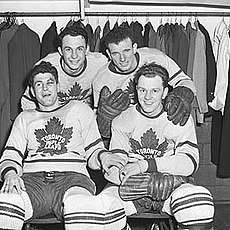
After the end of the war, players who had enlisted were beginning to return to their teams.[47] With Apps and Broda regaining their form, the Maple Leafs beat the first-place Canadiens in the 1947 finals.[47] In an effort to bolster their centre depth, the Leafs acquired Cy Thomas and Max Bentley in the following the off-season. With these key additions, the Leafs were able to win a second consecutive Stanley Cup, sweeping the Red Wings in the 1948 finals.[47] With their victory in 1948, the Leafs moved ahead of Montreal as the team having won the most Stanley Cups in League history. Apps announced his retirement following the 1948 finals, with Ted Kennedy replacing him as the team's captain.[49] Under a new captaincy, the Leafs managed to make it to the 1949 finals, facing the Red Wings, who had finished the season with the best overall record. However, the Leafs went on to win their third consecutive Cup, sweeping the Red Wings in four games. This brought the total of Detroit's play off game losses against the Leafs to eleven.[47] The Red Wings were able to end this losing streak in the following post-season, eliminating Toronto in the 1950 NHL playoffs.[47]
The Barilko Curse (1950s)
The Maple Leafs and Canadiens met again in the 1951 finals, with five consecutive overtime games played in the series.[50] Defenceman Bill Barilko managed to score the series-winning goal in overtime, leaving his defensive position (in spite of coach Joe Primeau's instructions not to) to pick up an errant pass and score.[50] Barilko helped the club secure its fourth Stanley Cup in five years. His glory was short-lived, as he disappeared in a plane crash near Timmins, Ontario, four months later.[50][51] The crash site was not found until a helicopter pilot discovered the plane's wreckage plane about 80 kilometres (50 mi) north of Cochrane, Ontario 11 years later.[52] The Leafs did not win another Cup during the 1950s, with rumours swirling that the team was "cursed", and would not win a cup until Barilko's body was found.[53] The "curse" came to an end after the Leafs' 1962 Stanley Cup victory, which came six weeks before to the discovery of the wreckage of Barilko's plane.[53]
Their 1951 victory was followed by lacklustre performances in the following seasons. The team finished third in the 1951–52 season, and were eventually swept by the Red Wings in the semi-finals.[50] With the conclusion of the 1952–53 regular season, the Leafs failed to make it to the post-season for the first time since the 1945–46 playoffs.[50] The Leafs' poor performance may be attributed partly to a decline in their sponsored junior system (including the Toronto St. Michael's Majors and the Toronto Marlboros).[50] The junior system was managed by Frank J. Selke until his departure to the Canadiens in 1946. In his absence, the quality of players it produced declined. Many who were called up to the Leafs in the early 1950s were found to be seriously lacking in ability. It was only later in the decade that the Leafs' feeder clubs produced prospects that helped them become competitive again.[50]
After a two-year drought from the playoffs, the Maple Leafs clinched a berth after the 1958–59 season. Under Punch Imlach, their new general manager and coach, the Leafs made it to the 1959 Finals, losing to the Canadiens in five games.[50] Building on a successful playoff run, the Leafs followed up with a second-place finish in the 1959–60 regular season. Although they advanced to their second straight Cup Finals, the Leafs were again defeated by the Canadiens in four games.[50]
New owners and a new dynasty (1961–1971)
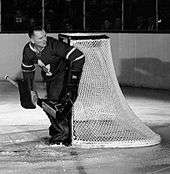
Beginning in the 1960s, the Leafs became a stronger team, with Johnny Bower as goaltender, and Bob Baun, Carl Brewer, Tim Horton and Allan Stanley serving as the Maple Leafs' defencemen.[54] In an effort to bolster their forward group during the 1960 off-season, Imlach traded Marc Reaume to the Red Wings for Red Kelly. Originally a defenceman, Kelly was asked to make the transition to the role of centre, where he remained for the rest of his career.[54] Kelly helped reinforce a forward group made up of Frank Mahovlich, and team captain George Armstrong. The beginning of the 1960–61 season also saw the debut of rookies Bob Nevin, and Dave Keon. Keon previously played for the St. Michael's Majors (the Maple Leafs junior affiliate), but had impressed Imlach during the Leafs' training camp, and joined the team for the season.[54] Despite these new additions, the Leafs' 1961 playoff run ended in the semifinals against the Red Wings, with Armstrong, Bower, Kelly and others, suffering from injuries.[54]
In November 1961, Smythe sold nearly all of his shares in the club's parent company, Maple Leaf Gardens Limited (MLGL), to a partnership composed of his son Stafford Smythe, and his partners, newspaper baron John Bassett and Toronto Marlboros President Harold Ballard. The sale price was $2.3 million (equivalent to $19,543,000 in 2018), a handsome return on Smythe's original investment 34 years earlier.[55] Initially, Conn Smythe claimed that he knew nothing about his son's partners and was furious with the arrangement (though it is highly unlikely he could have believed Stafford could have financed the purchase on his own). However, he did not stop the deal because of it.[56] Conn Smythe was given a retiring salary of $15,000 per year for life, an office, secretary, a car with a driver, and seats to home games.[57] Smythe sold his remaining shares in the company, and resigned from the board of directors in March 1966, after a Muhammad Ali boxing match was scheduled for the Gardens. Smythe found Ali's refusal to serve in the United States Army offensive, noting that the Gardens was "no place for those who want to evade conscription in their own country".[58] He had also said that because the Gardens' owners agreed to host the fight they had "put cash ahead of class".[59]
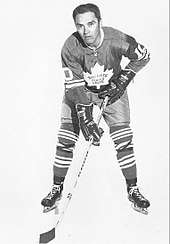
Under the new ownership, Toronto won another three straight Stanley Cups. The team won the 1962 Stanley Cup Finals beating the defending champion Chicago Black Hawks on a goal from Dick Duff in Game 6.[60] During the 1962–63 season, the Leafs finished first in the league for the first time since the 1947–48 season. In the following playoffs, the team won their second Stanley Cup of the decade.[54] The 1963–64 season saw certain members of the team traded. With Imlach seeking to reinvigorate the slumping Leafs, he made a mid-season trade that sent Duff, and Nevin to the Rangers for Andy Bathgate and Don McKenney. The Leafs managed to make the post-season as well as the Cup finals. In game six of the 1964 Cup finals, Baun suffered a fractured ankle and required a stretcher to be taken off the ice. He returned to play with his ankle frozen, and eventually scored the game-winning goal in overtime against the Red Wings.[61][54] The Leafs won their third consecutive Stanley Cup in a 4–0 game 7 victory; Bathgate scored two goals.[54]
The two seasons after the Maple Leafs' Stanley Cup victories, the team saw several player departures, including Bathgate, and Brewer, as well as several new additions, including Marcel Pronovost, and Terry Sawchuk.[54] During the 1966–67, the team had lost 10 games in a row, sending Imlach to the hospital with a stress-related illness. However, from the time King Clancy took over as the head coach, to Imlach's return, the club was on a 10-game undefeated streak, building momentum before the playoffs.[54] The Leafs made their last Cup finals in 1967. Playing against Montreal, the heavy favourite for the year, the Leafs managed to win, with Bob Pulford scoring the double-overtime winner in game three; Jim Pappin scored the series winner in Game 6.[62] Keon was named the playoff's most valuable player, and was awarded the Conn Smythe Trophy.[63]
From 1968 to 1970, the Maple Leafs made it to the playoffs only once. They lost several players to the 1967 expansion drafts, and the team was racked with dissension because of Imlach's authoritative manner, and his attempts to prevent the players from joining the newly formed Players' Association.[54] Imlach's management of the team was also brought into question due to some of his decisions. It was apparent that he was too loyal to aging players who had been with him since 1958.[54] In 1967–68 season, Mahovlich was traded to Detroit in a deal that saw the Leafs acquire Paul Henderson, and Norm Ullman.[64] The Leafs managed to return to the playoffs after the 1968–69 season, only to be swept by the Bruins. Immediately after, Stafford Smythe confronted Imlach and fired him.[65] This act was not without controversy, with some older players, including Horton, declaring that, "if this team doesn't want Imlach, I guess it doesn't want me".[66]
The Maple Leafs completed the 1969–70 season out of the playoffs. With their low finish, the Leafs were able to draft Darryl Sittler at the 1970 NHL Amateur Draft.[67] The Leafs returned to the playoffs after the 1970–71 season with the addition of Sittler, as well as Bernie Parent and Jacques Plante, who were both acquired through trades during the season.[68] They were eliminated in the first round against the Rangers.[69]
The Ballard years (1971–1990)
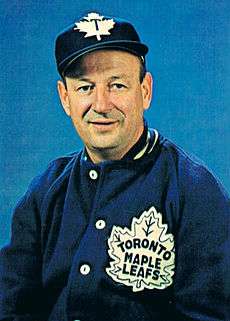
A series of events in 1971 made Harold Ballard the primary owner of the Maple Leafs. After a series of disputes between Bassett, Ballard and Stafford Smythe, Bassett sold his stake in the company to them.[70] Shortly afterwards, Smythe died in October 1971. Under the terms of Stafford's will, of which Ballard was an executor, each partner was allowed to buy the other's shares upon their death.[70] Stafford's brother and son tried to keep the shares in the family,[71] but in February 1972 Ballard bought all of Stafford's shares for $7.5 million, valuing the company at $22 million (equivalent to $134,009,000 in 2018).[72][73][74] Six months later, Ballard was convicted of charges including fraud, and theft of money and goods, and spent a year at Milhaven Penitentiary.[68][70]
By the end of 1971, the World Hockey Association (WHA) began operations as a direct competitor to the NHL. Believing the WHA would not be able to compete against the NHL, Ballard's attitude caused the Maple Leafs to lose key players, including Parent to the upstart league.[68] Undermanned and demoralized, the Leafs finished with the fourth-worst record for the 1972–73 season. They got the fourth overall pick in the 1973 NHL Amateur Draft,[68] and drafted Lanny McDonald. General Manager Jim Gregory also acquired the 10th overall pick from the Philadelphia Flyers, and the 15th overall pick from the Bruins, using them to acquire Bob Neely and Ian Turnbull.[68] In addition to these first round picks, the Leafs also acquired Börje Salming during the 1973 off-season.[75]
Despite acquiring Tiger Williams in the 1974 draft, and Roger Neilson as head coach in the 1977–78 season, the Maple Leafs found themselves eliminated in the playoffs by stronger Flyers or Canadiens teams from 1975 to 1979.[68] Although Neilson was a popular coach with fans and his players, he found himself at odds with Ballard, who fired him late in the 1977–78 season. Nielson was later reinstated after appeals from the players and public.[76] He continued as Leafs' head coach until after the 1979 playoffs, when he was fired again, alongside Gregory.[68] Gregory was replaced by Imlach as General Manager.[68]
In the first year of his second stint as general manager, Imlach became embroiled in a dispute with Leafs' captain Darryl Sittler over his attempt to take part in the Showdown series for Hockey Night in Canada.[68][77] In a move to undermine Sittler's influence on the team, Imlach traded McDonald, who was Sittler's friend.[78] By the end of the 1979–80 season, Imlach had traded away nearly half of the roster he had at the beginning of his tenure as general manager.[79] With the situation between Ballard and Sittler worsening, Sittler asked to be traded.[80] Forcing the Leafs' hand, the club's new general manager, Gerry McNamara, traded Sittler to the Flyers on January 20, 1982.[81] Rick Vaive was named the team's captain shortly after Sittler's departure.[79]
The Maple Leafs' management continued in disarray throughout most of the decade, with an inexperienced McNamara named as Imlach's replacement in September 1981.[79] He was followed by Gord Stellick on April 28, 1988, who was replaced by Floyd Smith on August 15, 1989.[79] Coaching was similarly shuffled often after Nielson's departure. Imlach's first choice for coach was his former player Smith, although he did not finish the 1979–80 season after being hospitalized by a car accident on March 14, 1980.[82] Joe Crozier was named the new head coach until January 10, 1981, when he was succeeded by Mike Nykoluk. Nykoluk was head coach until April 2, 1984.[79] Dan Maloney returned as head coach from 1984 to 1986, with John Brophy named head coach from 1986 to 1988. Both coaches had little success during their tenures.[79][83] Doug Carpenter was named the new head coach to begin the 1989–90 season, when the Leafs posted their first season above .500 in the decade.[79]
The team did not have much success during the decade, missing the playoffs entirely in 1982, 1984 and 1985.[79] On at least two occasions, they made the playoffs with the worst winning percentages on record for a playoff team. However, in those days, the top four teams in each division made the playoffs, regardless of record. In 1985–86, for instance, they finished with a .356 winning percentage, fourth-worst in the league. However, due to playing in a Norris Division where no team cracked the 90-point mark, the Leafs still made the playoffs. In 1987–88, they finished with the second-worst record in the league, and only one point ahead of the Minnesota North Stars for the worst record. However, the Red Wings were the only team in the division with a winning record, meaning that the Leafs and Stars were both in playoff contention on the season's final day. The Leafs upset the Red Wings in their final game, while the Stars lost to the Flames hours later to hand the Leafs the final spot from the Norris.
However, the low finishes allowed the team to draft Wendel Clark first overall at the 1985 NHL Entry Draft.[79] Clark managed to lead the Leafs to the playoffs from 1986 to 1988, as well as the 1990 playoffs.[79] Ballard died on April 11, 1990.[84]
Resurgence (1990–2004)
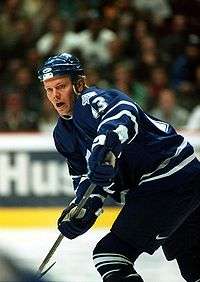
Don Crump, Don Giffin, and Steve Stavro were named executors of Ballard's estate.[85] Stavro succeeded Ballard as chairman of Maple Leaf Gardens Ltd. and governor of the Maple Leafs.[86] Cliff Fletcher was hired by Giffin to be the new general manager, although this was opposed by Stavro, who told Fletcher that he wanted to appoint his own general manager.[87] In 1992, Fletcher set about building a competitive club, hiring Pat Burns as the new coach, and by making a series of trades and free agent acquisitions, such as acquiring Doug Gilmour and Dave Andreychuk, which turned the Leafs into a contender.[88] Assisted by stellar goaltending from minor league call-up Felix Potvin, the team posted a then-franchise-record 99 points.[89]
Toronto dispatched the Detroit Red Wings in seven games in the first round, then defeated the St. Louis Blues in another seven games in the Division Finals.[88] Hoping to meet long-time rival Montreal (who was playing in the Wales Conference finals against the New York Islanders) in the Cup finals, the Leafs faced the Los Angeles Kings in the Campbell Conference finals.[88] They led the series 3–2, but dropped game six in Los Angeles. The game was not without controversy, as Wayne Gretzky clipped Gilmour in the face with his stick, but referee Kerry Fraser did not call a penalty, and Gretzky scored the winning goal moments later.[90] The Leafs eventually lost in game seven 5–4.[88]
The Leafs had another strong season in 1993–94, starting the season on a 10-game winning streak, and finishing it with 98 points.[88] The team made it to the conference finals again, only to be eliminated by the Vancouver Canucks in five games.[88] At the 1994 NHL Entry Draft, the Leafs packaged Wendel Clark in a multi-player trade with the Quebec Nordiques that landed them Mats Sundin.[88] Missing two consecutive playoffs in 1997 and 1998, the Leafs relieved Fletcher as general manager.[88]
New home and a new millennium (1998–2004)
On February 12, 1998, MLGL purchased the Toronto Raptors, a National Basketball Association franchise, and the arena the Raptors were building, from Allan Slaight and Scotiabank.[91][92][93] With the acquisition, MLGL was renamed to Maple Leaf Sports & Entertainment (MLSE), acting as the parent company of the two teams.[93] Larry Tanenbaum was a driving force in the acquisition, having bought a 12.5 percent stake in Maple Leaf Gardens Limited (MLGL) in 1996.[94][95]
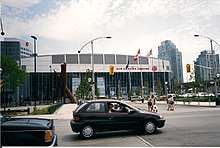
Curtis Joseph was acquired as the team's starting goalie, while Pat Quinn was hired as the head coach before the 1998–99 season.[88] Realigning the NHL's conferences in 1998, the Leafs were moved from the Western to the Eastern Conference.[92] On February 13, 1999, the Leafs played their final game at the Gardens before moving to their new home at the then-Air Canada Centre.[96] In the 1999 playoffs, the team advanced to the Conference Finals, but lost in five games to the Buffalo Sabres.[88]
In the 1999–2000 season, the Leafs hosted the 50th NHL All-Star Game.[97] By the end of the season, they recorded their first 100-point season and won their first division title in 37 years.[98] In both the 2000 and 2001 playoffs, the Leafs defeated the Ottawa Senators in the first round, and lost to the New Jersey Devils in the second round.[98][99] In 2002 playoffs, the Leafs dispatched the Islanders and the Senators in seven games each during the first two rounds, only to lose to the Cinderella-story Carolina Hurricanes in six games in the Conference Finals.[100] The 2002 season was particularly impressive in that injuries sidelined many of the Leafs' better players, but the efforts of depth players, including Alyn McCauley, Gary Roberts and Darcy Tucker, led them to the Conference Finals.[101]
As Joseph opted to become a free agent during the 2002 off-season, the Leafs signed Ed Belfour as the new starting goaltender.[102] Belfour played well during the 2002–03 season and was a finalist for the Vezina Trophy.[103] The Leafs lost to Philadelphia in seven games during the first round of the 2003 playoffs.[104] In 2003, an ownership change occurred in MLSE. Stavro sold his controlling interest in MLSE to the Ontario Teachers' Pension Plan (OTPP) and resigned his position as chairman in favour of Tanenbaum.[105] Quinn remained as head coach, but was replaced as general manager by John Ferguson Jr..[106]
Before the 2003–04 season, the team held their training camp in Sweden and played in the NHL Challenge against teams from Sweden and Finland.[107] The Leafs went on to enjoy a very successful regular season, leading the NHL at the time of the All-Star Game (with Quinn named head coach of the East's All-Star Team). They finished the season with a then-franchise-record 103 points.[108] They finished with the fourth-best record in the League, and their highest overall finish in 41 years, achieving a .628 win percentage, their best in 43 years, and third-best in franchise history. In the 2004 playoffs, the Leafs defeated the Senators in the first round of the post-season for the fourth time in five years, with Belfour posting three shutouts in seven games, but lost to the Flyers in six games during the second round.[108]
After the lock-out (2005–2014)
Following the 2004–05 NHL lockout, the Maple Leafs experienced their longest playoff drought in the club's history. They struggled in the 2005–06 season; despite a late-season surge (9–1–2 in their final 12 games), led by goaltender Jean-Sebastien Aubin, Toronto was out of playoff contention for the first time since 1998.[109] This marked the first time the team had missed the postseason under Quinn, who was later relieved as head coach.[110] Quinn's dismissal was controversial since many of the young players who were key contributors to the Leafs' late-season run had been drafted by him before Ferguson's arrival, while Ferguson's signings (Jason Allison, Belfour, Alexander Khavanov, and Eric Lindros) had suffered season-ending injuries.[110][111]
Paul Maurice, who had previously coached the inaugural season of the Maple Leafs' Toronto Marlies farm team, was named as Quinn's replacement.[112] On June 30, 2006, the Leafs bought out fan-favourite Tie Domi's contract. The team also decided against picking up the option year on goaltender Ed Belfour's contract; he became a free agent.[113] However, despite the coaching change, as well as a shuffle in the roster, the team did not make the playoffs in 2006–07. During the 2007–08 season, John Ferguson, Jr. was fired in January 2008, and replaced by former Leafs' general manager Cliff Fletcher on an interim basis.[114] The team retained Toronto-based sports lawyer Gord Kirke to begin a search for a new team president and general manager, and negotiate a contract.[115] The Leafs did not qualify for the post-season, marking the first time since 1928 the team had failed to make the playoffs for three consecutive seasons.[116] It was also Sundin's last year with the Leafs, as his contract was due to expire at the end of the season. However, he refused Leafs management's request to waive his no-trade clause in order for the team to rebuild by acquiring prospects and/or draft picks.[117] On May 7, 2008, after the 2007–08 season, the Leafs fired Maurice, as well as assistant coach Randy Ladouceur, naming Ron Wilson as the new head coach, and Tim Hunter and Rob Zettler as assistant coaches.[118]
On November 29, 2008, the Maple Leafs hired Brian Burke as their 13th non-interim, and the first American, general manager in team history. The acquisition ended the second Cliff Fletcher era and settled persistent rumours that Burke was coming to Toronto.[119] On June 26, 2009, Burke made his first appearance as the Leafs GM at the 2009 NHL Entry Draft, selecting London Knights forward Nazem Kadri with the seventh overall pick.[120] On September 18, 2009, Burke traded Toronto's first- and second-round 2010, as well as its 2011 first-round picks, to the Boston Bruins in exchange for forward Phil Kessel.[121] On January 31, 2010, the Leafs made another high-profile trade, this time with the Calgary Flames in a seven-player deal that brought defenceman Dion Phaneuf to Toronto.[122] On June 14, during the off-season, the Leafs named Phaneuf captain after two seasons without one following Sundin's departure.[123] On February 18, 2011, the team traded long-time Maple Leafs defenceman Tomas Kaberle to the Bruins in exchange for prospect Joe Colborne, Boston's first-round pick in 2011, and a conditional second-round draft choice.[124]
On March 2, 2012, Burke fired Wilson and named Randy Carlyle the new head coach. However, the termination proved to be controversial as Wilson had received a contract extension just two months prior to being let go.[125] Changes at the ownership level also occurred in August 2012, when the OTPP completed the sale of their shares in MLSE to BCE Inc. and Rogers Communications.[126] On January 9, 2013, Burke was fired as general manager, replaced by Dave Nonis.[127] In their first full season under the leadership of Carlyle, Toronto managed to secure a playoff berth in the 2012–13 season (which was shortened again due to another lock-out) for the first time in eight years. However, the Leafs lost in seven games to eventual 2013 Stanley Cup finalist Boston in the first round.[128] Despite the season's success, it was not repeated during the 2013–14 season, as the Leafs failed to make the playoffs.[129]
Brendan Shanahan era (2014–present)
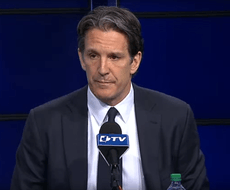
Shortly after the end of the 2013–14 regular season, Brendan Shanahan was named as the president and an alternate governor of the Maple Leafs.[130] On January 6, 2015, the Leafs fired Randy Carlyle as head coach, and assistant coach Peter Horachek took over on an interim basis immediately.[131] While the Leafs had a winning record before Carlyle's firing, the team eventually collapsed. On February 6, 2015, the Leafs set a new franchise record of 11 consecutive games without a win. At the beginning of February, Shanahan gained the approval of MLSE's Board of Directors to begin a "scorched earth" rebuild of the club.[132] Both Dave Nonis and Horachek were relieved of their duties on April 12, just one day after the season concluded. In addition, the Leafs also fired a number of assistant coaches, including Steve Spott, Rick St. Croix; as well as individuals from the Leafs' player scouting department.[133][134]
On May 20, 2015, Mike Babcock was named as the new head coach, and on July 23, Lou Lamoriello was named the 16th general manager in team history.[135][136] On July 1, 2015, the Leafs packaged Kessel in a multi-player deal to the Pittsburgh Penguins in return for three skaters, including Kasperi Kapanen, a conditional first round pick, and a third round pick. Toronto also retained $1.2 million of Kessel's salary for the remaining seven seasons of his contract.[137] During the following season, on February 9, 2016, the Leafs packaged Phaneuf in another multi-player deal, acquiring four players, as well as a 2017 second-round pick from the Ottawa Senators.[138] The team finished last in the NHL for the first time since the 1984–85 season. They subsequently won the draft lottery and used the first overall pick to draft Auston Matthews.[139]
.jpg)
In their second season under Babcock, Toronto secured the final Eastern Conference wildcard spot for the 2017 playoffs. On April 23, 2017, the Maple Leafs were eliminated from the playoffs by the top-seeded Washington Capitals four games to two in the best-of-seven series.[140]
Toronto finished the 2017–18 season with 105 points by beating Montreal 4–2 in their final game of the regular season, a franchise-record, beating the previous record of 103 points set in 2004.[141] They faced the Boston Bruins in the First Round and lost in seven games.[142] Following the playoffs, Lamoriello was not renewed as general manager.[143] Kyle Dubas was subsequently named the team's 17th general manager in May 2018.[144] During the 2018 off-season, the Maple Leafs signed John Tavares to a seven-year, $77 million contract.[145] On April 1, the Maple Leafs clinched a division berth for the 2019 Stanley Cup playoffs.[146] The Maple Leafs were eliminated in the First Round of the 2019 playoffs on April 23, after losing to the Bruins in a seven-game series.[147]
On October 2, 2019, Tavares was named as the team's 25th team captain prior to the Leafs' 2019–20 season opening game.[148] After a 9–10–4 start to the 2019–20 season, the club relieved Babcock as head coach on November 20, with Sheldon Keefe named as his replacement.[149]
Team culture
Fan base
The price of a Maple Leafs home game ticket is the highest amongst any team in the NHL.[150][151][152] Scotiabank Arena holds 18,900 seats for Leafs games, with 15,500 reserved for season ticket holders.[153] Because of the demand for season tickets, their sale is limited to the 10,000 people on the waiting list. As of March 2016, Leafs' season tickets saw a renewal rate of 99.5 percent, a rate that would require more than 250 years to clear the existing waiting list.[153] In a 2014 survey by ESPN The Magazine, the Leafs were ranked last out of the 122 professional teams in the Big Four leagues. Teams were graded by stadium experience, ownership, player quality, ticket affordability, championships won and "bang for the buck"; in particular, the Leafs came last in ticket affordability.[154]
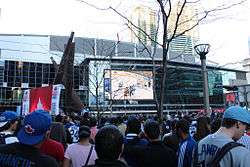
Leafs fans have been noted for their loyalty to the team in spite of their performance.[155][156] In a study conducted by sports retailer Fanatics in March 2017, the Leafs and the Minnesota Wild were the only two NHL teams to average arena sellouts, with average win percentages below the league's average.[157] Conversely, fans of other teams harbour an equally passionate dislike of the team. In November 2002, the Leafs were named by Sports Illustrated hockey writer Michael Farber as the "Most Hated Team in Hockey".[158]
Despite their loyalty, there have been several instances where the fanbase voiced their displeasure with the club. During the 2011–12 season, fans attending the games chanted for the dismissal of head coach Ron Wilson, and later general manager Brian Burke.[159][160] Wilson was let go shortly after the fans' outburst, even though he had been given a contract extension months earlier. Burke alluded to the chants noting "it would be cruel and unusual punishment to let Ron coach another game in the Air Canada Centre".[159] In the 2014–15 season, fans threw Leafs jerseys onto the ice to show their disapproval of the team's poor performances in the past few decades.[161] Similarly, during the later portion of the 2015–16 season, which overlaps with the start of Major League Baseball's regular season of play, fans were heard sarcastically chanting "Let's go Blue Jays!" as a sign of their farcical shift in priority from an under-performing team to the more successful 2016 Blue Jays season.[162][163][164] Leafs fans also vandalized Mike Babcock's Wikipedia article amid the poor records of the first few months into the 2019–20 season; his article was temporarily semi-protected to minimize further vandalism.[165]
In addition to the Greater Toronto Area (GTA), many fans live throughout Ontario, including the Ottawa Valley, the Niagara Region, and Southwestern Ontario.[166][167][168] As a result, Leafs’ away games at the Canadian Tire Centre in Ottawa, KeyBank Center in Buffalo, and at the Little Caesars Arena in Detroit host a more neutral attendance. This is due in part to the Leafs fans in those areas, and those cities' proximity to the GTA.[169][170][171]
The Leafs are also a popular team in Atlantic Canada. In November 2016, a survey was conducted that found 20 percent of respondents from Atlantic Canada viewed the Leafs as their favourite team, second only to the Montreal Canadiens at 26 percent.[172] The Leafs were found to be the most favoured team in Prince Edward Island, with 24 percent of respondents favouring the Leafs; and the second favourite team in Nova Scotia, and Newfoundland and Labrador (19 and 24 percent respectively, both trailing respondents who favoured the Canadiens by one percent).[172]
Rivalries
During the 25 years of the Original Six-era (1942–67), teams played each other 14 times during the regular season, and with only four teams continuing into the playoffs, rivalries were intense. The Maple Leafs established several rivalries with other teams that played in this era, including the Boston Bruins, Detroit Red Wings, and the Montreal Canadiens.[174] In addition to the aforementioned teams, the Maple Leafs have also developed a rivalry with the Ottawa Senators.[175]
Boston Bruins
Both teams are Original Six teams, with their first game played in Boston's inaugural season on December 3, 1924. In the match-up, the St. Patricks earned a 5–3 victory against the Bruins at Mutual Street Arena. The Maple Leafs played their first Stanley Cup playoff series against the Bruins in 1933, winning the series 3–2. From 1933 to 2019, the two teams played in 16 postseason series against one another, including one Stanley Cup Finals.
The rivalry has since been renewed from the 2013 Stanley Cup playoffs which saw the Bruins rally from a 4–1 third period deficit to defeat the Maple Leafs in overtime, 5–4, and advance to the second round.[176] In the 2018 and 2019 Stanley Cup playoffs, the Bruins would again defeat the Maple Leafs in seven games in both of those years.[177][178]
Detroit Red Wings
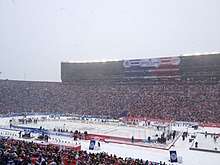
The Detroit Red Wings and the Maple Leafs are both Original Six teams, playing their first game together in 1927. From 1929 to 1993, the teams met each other in the 16 playoff series, as well as seven Stanley Cup Finals. Meeting one another for a combined 23 times in the postseason, they have played each other in more playoff series than any other two teams in NHL history with the exception of the Bruins and Canadiens who have played a total of 34 playoff series.[179] Overlapping fanbases, particularly in markets such as Windsor, Ontario and the surrounding Essex County, have added to the rivalry.[167]
The rivalry between the Detroit Red Wings and the Maple Leafs was at its height during the Original Six era.[173] The Leafs and Red Wings met in the playoffs six times during the 1940s, including four Stanley Cup finals. The Leafs beat the Red Wings in five of their six meetings.[180] In the 1950s, the Leafs and Red Wings met one another in six Stanley Cup semifinals; the Red Wings beat the Leafs in five of their six meetings.[181] From 1961 to 1967, the two teams met one another in three playoff series, including two Stanley Cup finals.[182] Within those 25 years, the Leafs and Red Wings played a total of 15 playoff series including six Cup Finals; the Maple Leafs beat the Red Wings in all six Cup Finals.[183]
The teams have only met three times in the playoffs since the Original Six era, with their last meeting in 1993.[184] After the Leafs moved to the Eastern Conference in 1998, they faced each other less often, and the rivalry began to stagnate. The rivalry became intradivisional once again in 2013, when Detroit was moved to the Atlantic Division of the Eastern Conference as part of a realignment.[185]
Montreal Canadiens
The rivalry between the Montreal Canadiens and the Maple Leafs is the oldest in the NHL, featuring two clubs that were active since the inaugural NHL season in 1917.[186] In the early 20th century, the rivalry was an embodiment of a larger culture war between English Canada and French Canada.[187] The Canadiens have won 24 Stanley Cups, while the Maple Leafs have won 13, ranking them first and second for most Cup wins.[186]

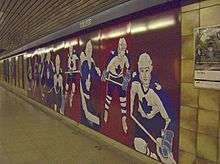
The height of the rivalry was during the 1960s, when the Canadiens and Leafs combined to win all but one Cup. The two clubs had 15 playoff meetings. However, failing to meet each other in the playoffs since 1979, the rivalry has waned.[186] It also suffered when Montreal and Toronto were placed in opposite conferences in 1981, with the Leafs in the Clarence Campbell/Western Conference and the Canadiens in the Prince of Wales/Eastern Conference. The rivalry became intradivisional once again in 1998, when the Leafs were moved into the Eastern Conference's Northeast Division.[188]
The rivalry's cultural imprint may be seen in literature and art. The rivalry from the perspective of the Canadiens fan is captured in the popular Canadian short story "The Hockey Sweater" by Roch Carrier. Originally published in French as "Une abominable feuille d'érable sur la glace" ("An abominable maple leaf on the ice"), it referred to the Maple Leafs sweater a mother forced her son to wear.[187] The son is presumably based on Carrier himself when he was young.[189] This rivalry is also evident in Toronto's College subway station, which displays murals depicting the two teams, one on each platform.[190]
Ottawa Senators
The modern Ottawa Senators entered the NHL in 1992, but the rivalry between the two teams did not begin to emerge until the late 1990s. From 1992 to 1998, Ottawa and Toronto played in different conferences (Eastern and Western respectively), which meant they rarely played each other. However, before the 1998–99 season, the conferences and divisions were realigned, with Toronto moved to the Eastern Conference's Northeast Division with Ottawa.[188] From 2000 to 2004, the teams played four post-season series; the Leafs won all four playoff series.[175] Due in part to the number Leafs fans living in the Ottawa Valley, and in part to Ottawa's proximity to Toronto, Leafs–Senators games at the Canadian Tire Centre in Ottawa hold a more neutral audience.[191][169][192]
Team information
Broadcasters
As a result of both Bell Canada and Rogers Communications having an ownership stake in MLSE, Maple Leafs broadcasts are split between the two media companies; with regional TV broadcasts split between Rogers' Sportsnet Ontario and Bell's TSN4.[3][193] Colour commentary for Bell's television broadcasts is performed by Ray Ferraro, while play-by-play is provided by Chris Cuthbert and Gord Miller.[194] Colour commentary for Rogers' television broadcasts is performed by Greg Millen, while play-by-play is provided by John Bartlett.[195] MLSE also operates a regional specialty channel, the Leafs Nation Network.[196] The Leafs Nation Network broadcasts programming related to the Maple Leafs, as well as games for the Toronto Marlies, the Maple Leafs' American Hockey League affiliate.[197]
Like the Maple Leafs television broadcasts, radio broadcasts are split evenly between Rogers' CJCL (Sportsnet 590, The Fan) and Bell's CHUM (TSN Radio 1050).[3] Both Bell and Rogers' radio broadcasts have their colour commentary provided by Jim Ralph, with play-by-play provided by Joe Bowen.
Radio broadcasts of games played by the club were started in 1923.[198] The first Leafs hockey game that was televised occurred on November 10, 1952; the broadcast also being the first English-language television broadcast of an NHL game in Canada.[198] Foster Hewitt was the Leafs' first play-by-play broadcaster, providing radio play-by-play from 1927 to 1978. In addition, he provided play-by-play for television from 1952 to 1958, and colour commentary from 1958 to 1961.[199] Originally aired over CFCA, Hewitt's broadcast was picked up by the Canadian Radio Broadcasting Commission (the CRBC) in 1933, moving to CBC Radio (the CRBC's successor) three years later.[200]
Home arenas and practice facilities
| Home arenas | |
| Arena | Tenure |
|---|---|
| Arena Gardens | 1917–1931 |
| Maple Leaf Gardens | 1931–1999 |
| Scotiabank Arena | 1999–present |
The team's first home was the Arena Gardens, later known as the Mutual Street Arena. From 1912 until 1931, the Arena was ice hockey's premier site in Toronto.[201] The Arena Gardens was the third arena in Canada to feature a mechanically-frozen, or artificial, ice surface, and for 11 years was the only such facility in Eastern Canada.[202] The Arena was demolished in 1989, with most of the site converted to residential developments.[203] In 2011, parts of the site were made into a city park, known as Arena Gardens.[204]
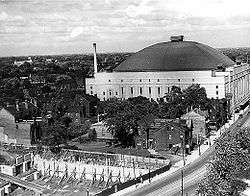
In 1931, over a six-month period, Conn Smythe built Maple Leaf Gardens on the northwest corner of Carlton Street and Church Street, at a cost of C$1.5 million (C$24.4 million in 2020).[205] The arena soon acquired nicknames including the "Carlton Street Cashbox", and the "Maple Leaf Mint", since the team's games were constantly sold out.[206] The Maple Leafs won 11 Stanley Cups while playing at the Gardens. The first annual NHL All-Star Game was also held at Maple Leaf Gardens in 1947.[207] The Gardens opened on November 12, 1931, with the Maple Leafs losing 2–1 to the Chicago Blackhawks.[33] On February 13, 1999, the Maple Leafs played their last game at the Gardens, suffering a 6–2 loss to the Blackhawks.[96] The building is presently used as a multi-purpose facility, with a Loblaws grocery store occupying retail space on the lower floors, Joe Fresh and LCBO occupying another floor, and an athletics arena for Ryerson University, occupying the topmost level.[208][209]
The Maple Leafs presently use two facilities in the City of Toronto. The club moved from the Gardens on February 20, 1999, to their current home arena, the Air Canada Centre, a multi-purpose indoor entertainment arena on Bay Street in Downtown Toronto.[210] The arena is owned by the Maple Leafs' parent company MLSE, and is shared with the NBA's Toronto Raptors (another MLSE subsidiary), as well as the National Lacrosse League's Toronto Rock.[211] In addition to the main arena, the Maple Leafs also operate a practice facility at the Ford Performance Centre. The facility was opened in 2009, and operated by the Lakeshore Lions Club until September 2011, when the City of Toronto took over ownership of the facility after the Lions Club faced financial difficulties. The facility now operates as a City of Toronto controlled corporation.[212][213] The facility was known as the Mastercard Centre for Hockey Excellence until 2019, when it was renamed the Ford Performance Centre. The facility has three NHL rinks and one Olympic-sized rink.[213]
On January 1, 2017, the Maple Leafs played the Detroit Red Wings in a home game at BMO Field, an outdoor multipurpose stadium at Exhibition Place. Known as the NHL Centennial Classic, the outdoor game served as a celebration for both the centennial season of the franchise and the NHL.[214]
Logo and uniform
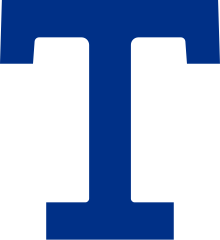

The team is represented through a number of images and symbols, including the maple leaf logo found on the club's uniform, and their mascot. The Maple Leafs' jersey has a long history and is one of the best-selling NHL jerseys among fans.[215] The club's uniforms have been altered several times. The club's first uniforms were blue and featured the letter T.[216] The first major alteration came in 1919, when the club was renamed the St. Patricks. The uniforms were green with "Toronto St. Pats" on the logo, lettered in green either on a white "pill" shape or stripes.[17][217]
When the club was renamed the Maple Leafs in the 1927–28 season, the logo was changed, and the team reverted to blue uniforms.[29] The logo was a 48-point maple leaf with the words lettered in white. The home jersey was blue with alternating thin-thick stripes on the arms, legs and shoulders. The road uniform was white with three stripes on the chest and back, waist and legs.[218] For 1933–34, the alternating thin-thick stripes were replaced with stripes of equal thickness. This remained the basic design for the next 40 years.[218] In 1937, veins were added to the leaf and "Toronto" curved downwards at the ends instead of upwards.[219] In 1942, the 35-point leaf was introduced. In 1946, the logo added trimming to the leaf with a white or blue border, while "C" for captain and "A" for alternate captain first appeared on the sweaters. In 1947, the "Toronto Maple Leafs" lettering was in red for a short time. In 1958, a six-eyelet lace and tie was added to the neck and a blue shoulder yoke was added. In 1961, player numbers were added on the sleeves.[220]
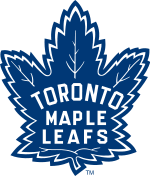
The fourth major change came in the 1966–67 season, when the logo was changed to an 11-point leaf, similar to the leaf on the then-new flag of Canada to commemorate the Canadian Centennial.[220] The simpler leaf logo featured the Futura Display typeface, replacing the previous block letters. The stripes on the sleeves and waistline were also changed, adding a wider stripe in between the two thinner stripes (similar to the stripe patterns on the socks and on the early Leafs sweaters). Before the 1970–71 season, the Leafs adopted a new 11-point leaf logo, with a Kabel bold-font "Toronto" going straight across, running parallel to the other words. Other changes to the sweater included the replacement of the arm strips with an elongated yoke that extended to the ends of the sleeves, a solid single stripe on the waist replacing the three waistline stripes, two stripes on the stockings, and a smaller, textless Leaf crest on the shoulders.[221] In 1973, the jersey's neck was a lace tie-down design, before the V-neck returned in 1976. In 1977, the NHL rules were changed to require names on the backs of the uniforms, but Harold Ballard resisted the change. Under Ballard's direction, the team briefly "complied" with the rule by placing blue letters on the blue road jersey for a game on February 26, 1978. With the NHL threatening hefty fines for failing to comply with the spirit of the rule (namely, having the names be legible for the fans and broadcasters in attendance), Ballard reached a compromise with the league, allowing the Leafs to finish the 1977–78 season with contrasting white letters on the road sweaters, and coming into full compliance with the new rule in the 1978–79 season by adding names in blue to the white home sweaters.[221]
With the NHL's 75th anniversary season (1991–92 season), the Leafs wore "Original Six" style uniforms similar to the designs used in the 1940s.[221] Because of the fan reaction to the previous season's classic uniforms, the first changes to the Maple Leafs uniform in over 20 years were made. The revised uniforms for 1992–93 featured two stripes on the sleeves and waistline like the classic uniform, but with the 1970 11-point leaf with Kabel text on the front. A vintage-style veined leaf crest was placed on the shoulders.[221] The uniforms would undergo a few modifications over the years.
.jpg)
In 1997, Nike acquired the rights to manufacture Maple Leafs uniforms. Construction changes to the uniform included a wishbone collar and pothole mesh underarms, while the player name and number font was changed to Kabel to match the logo. CCM returned to manufacturing the Leafs uniforms in 1999 when Nike withdrew from the hockey jersey market, and kept most of the changes, although in 2000 the Kabel numbers were replaced with block numbers outlined in silver, and a silver-outlined interlocked TML monogram replaced the vintage leaf on the shoulders. Also during this time, the Leafs began wearing a white 1960s-style throwback third jersey featuring the outlined 35-point leaf, blue shoulders, and lace-up collar.
With Reebok taking over the NHL jersey contract following the 2004–05 lock-out, changes were expected when the Edge uniform system was set to debut in 2007. As part of the Edge overhaul, the TML monograms were removed from the shoulders, the silver outlines on the numbers were replaced with blue or white outlines (e.g. the blue home jersey featured white numbers with blue and white outlines, rather than blue and silver), and the waistline stripes were removed. In 2010, the two waistline stripes were restored, the vintage leaf returned to the shoulders, and the player names and numbers were changed again, reverting to a simpler single-colour block font. Finally, lace-up collars were brought back to the primary uniforms.[215][222] The Leafs also brought back the 1967–1970 blue uniform, replacing the white 1960s jersey as their third uniform. For the 2014 NHL Winter Classic, the Leafs wore a sweater inspired by their earlier uniforms in the 1930s.[222]
On February 2, 2016, the team unveiled a new logo for the 2016–17 season in honour of its centennial, dropping the use of the Kabel-style font lettering used from 1970; it returns the logo to a form inspired by the earlier designs, with 31 points to allude to the 1931 opening of Maple Leaf Gardens, and 17 veins a reference to its establishment in 1917. 13 of the veins are positioned along the top part in honour of its 13 Stanley Cup victories. The logo was subsequently accompanied by a new uniform design that was unveiled during the 2016 NHL Entry Draft on June 24, 2016.[223][224][225] In addition to the new logo, the new uniforms feature a custom block typeface for the player names and numbers. Two stripes remain on the sleeves, with a single stripe at the waistline. The updated design carried over to the Adidas Adizero uniform system in 2017.
The Maple Leafs have in recent years occasionally worn a St. Pats throwback uniform for select games in 2003 and 2017, the latter as part of the franchise's centennial celebration. For the 2018 season, the Leafs also wore a Toronto Arenas-inspired throwback design. In addition, the Leafs participated in two outdoor games as part of the NHL's own centennial celebration. In the NHL Centennial Classic against the Red Wings, the Leafs wore blue sweaters with bold white stripes across the chest and arms. For the 2018 NHL Stadium Series, the Leafs wore white uniforms with two blue stripes across the chest and arms, and in an unusual move, paired this uniform with white pants.
Mascot
The Maple Leafs' mascot is Carlton the Bear, an anthropomorphic polar bear whose name and number (#60) comes from the location of Maple Leaf Gardens at 60 Carlton Street, where the Leafs played throughout much of their history.[226] Carlton made his first public appearance on July 29, 1995. He later made his regular season appearance on October 10, 1995.[227]
Minor league affiliates
The Maple Leafs are presently affiliated with two minor league teams, the Toronto Marlies of the American Hockey League and the Newfoundland Growlers of the ECHL. The Marlies play from Coca-Cola Coliseum in Toronto. Prior to its move to Coca-Cola Coliseum in 2005, the team was located in St. John's, Newfoundland and was known as the St. John's Maple Leafs.[228] The Marlies originated from the New Brunswick Hawks, who later moved to St. Catherines, Newmarket, and St. John's, before finally moving to Toronto.[229][230] The Marlies was named after the Toronto Marlboros, a junior hockey team named after the Duke of Marlborough.[228] Founded in 1903, the Marlboros were sponsored by the Leafs from 1927 to 1989.[228][231] The Marlboros constituted one of two junior hockey teams the Leafs formerly sponsored, the other being the Toronto St. Michael's Majors.[50]
The Growlers are an ECHL team based in St. John's, Newfoundland. The Growlers became affiliated with the Maple Leafs and the Marlies before the 2018–19 season.[232] Unlike the Marlies, the Growlers are not owned by the Leafs' parent company, but are instead owned by a local ownership group in St. John's called Deacon Investments Ltd.
Ownership
The Maple Leafs is one of six professional sports teams owned by Maple Leaf Sports & Entertainment (MLSE). In 2018, Forbes estimated the value of the club at US$1.45 billion, making the Maple Leafs the second most valuable franchise in the NHL, after the New York Rangers.[233] However, MLSE has refuted past valuations made by Forbes.[234]
Initially ownership of the club was held by the Arena Gardens of Toronto, Limited; an ownership group fronted by Henry Pellatt, that owned and managed Arena Gardens.[235] The club was named a permanent franchise in the League following its inaugural season, with team manager Charles Querrie, and the Arena Gardens treasurer Hubert Vearncombe as its owners.[236] The Arena Company owned the club until 1919, when litigations from Eddie Livingstone forced the company to declare bankruptcy. Querrie brokered the sale of the Arena Garden's share to the owners of the amateur St. Patricks Hockey Club.[237][238] Maintaining his shares in the club, Querrie fronted the new ownership group until 1927, when the club was put up for sale. Toronto Varsity Blues coach Conn Smythe put together an ownership group and purchased the franchise for $160,000.[22] In 1929, Smythe decided, in the midst of the Great Depression, that the Maple Leafs needed a new arena.[32][33] To finance it, Smythe launched Maple Leaf Gardens Limited (MLGL), a publicly traded management company to own both the Maple Leafs and the new arena, which was named Maple Leaf Gardens. Smythe traded his stake in the Leafs for shares in MLGL, and sold shares in the holding company to the public to help fund construction for the arena.[239]
Although Smythe was the face of MLGL from its founding, he did not gain controlling interest in the company until 1947.[240][241][242] Smythe remained MLGL's principal owner until 1961, when he sold 90 percent of his shares to an ownership group consisting of Harold Ballard, John Bassett and Stafford Smythe. Ballard became majority owner in February 1972, shortly following the death of Stafford Smythe.[74] Ballard was the principal owner of MLGL until his death in 1990. The company remained a publicly traded company until 1998, when an ownership group fronted by Steve Stavro privatized the company by acquiring more than the 90 percent of stock necessary to force objecting shareholders out.[243][244]
While initially primarily a hockey company, with ownership stakes in a number of junior hockey clubs including the Toronto Marlboros of the Ontario Hockey Association, the company later branched out to own the Hamilton Tiger-Cats of the Canadian Football League from the late 1970s to late 1980s.[245] On February 12, 1998, MLGL purchased the Toronto Raptors of the National Basketball Association, who were constructing the then-Air Canada Centre. After MLGL acquired the Raptors, the company changed its name to MLSE.[93] The company's portfolio has since expanded to include the Toronto FC of Major League Soccer, the Toronto Marlies of the AHL, the Toronto Argonauts of the Canadian Football League, and a 37.5 percent stake in Maple Leaf Square.[246]
The present ownership structure emerged in 2012, after the Ontario Teachers' Pension Plan (the company's former principal owner) announced the sale of its 75 percent stake in MLSE to a consortium made up of Bell Canada and Rogers Communications, in a deal valued at $1.32 billion.[247] As part of the sale, two numbered companies were created to jointly hold stock. This ownership structure ensures that, at the shareholder level, Rogers and Bell vote their overall 75 percent interest in the company together and thus decisions on the management of the company must be made by consensus between the two.[248] A portion of Bell's share in MLSE is owned by its pension fund, in order to make Bell's share in MLSE under 30 percent. This was done so that Bell could retain its existing 18 percent interest in the Montreal Canadiens; as NHL rules prevent any shareholder that owns more than 30 percent of a team from holding an ownership position in another.[249] The remaining 25 percent is owned by Larry Tanenbaum, who is also the chairman of MLSE.[247]
| Ownership structure of Maple Leafs Sports & Entertainment | |||||||||||||||||||||||||||||||||||||||||||||||||||||||||||||||||||||||||||||||||||||||||||||||||||||||||||||||||||||||||||||||||||||||||||||||||||||||||||||||||||||||||||||||||||||||||
|---|---|---|---|---|---|---|---|---|---|---|---|---|---|---|---|---|---|---|---|---|---|---|---|---|---|---|---|---|---|---|---|---|---|---|---|---|---|---|---|---|---|---|---|---|---|---|---|---|---|---|---|---|---|---|---|---|---|---|---|---|---|---|---|---|---|---|---|---|---|---|---|---|---|---|---|---|---|---|---|---|---|---|---|---|---|---|---|---|---|---|---|---|---|---|---|---|---|---|---|---|---|---|---|---|---|---|---|---|---|---|---|---|---|---|---|---|---|---|---|---|---|---|---|---|---|---|---|---|---|---|---|---|---|---|---|---|---|---|---|---|---|---|---|---|---|---|---|---|---|---|---|---|---|---|---|---|---|---|---|---|---|---|---|---|---|---|---|---|---|---|---|---|---|---|---|---|---|---|---|---|---|---|---|---|---|
| |||||||||||||||||||||||||||||||||||||||||||||||||||||||||||||||||||||||||||||||||||||||||||||||||||||||||||||||||||||||||||||||||||||||||||||||||||||||||||||||||||||||||||||||||||||||||
Season-by-season record
This is a partial list of the last five seasons completed by the Maple Leafs. For the full season-by-season history, see List of Toronto Maple Leafs seasons
Note: GP = Games played, W = Wins, L = Losses, T = Ties, OTL = Overtime Losses, Pts = Points, GF = Goals for, GA = Goals against
| Season | GP | W | L | OTL | Pts | GF | GA | Finish | Playoffs |
| 2015–16 | 82 | 29 | 42 | 11 | 69 | 198 | 246 | 8th, Atlantic | Did not qualify |
| 2016–17 | 82 | 40 | 27 | 15 | 95 | 251 | 242 | 4th, Atlantic | Lost in First Round, 2–4 (Capitals) |
| 2017–18 | 82 | 49 | 26 | 7 | 105 | 277 | 232 | 3rd, Atlantic | Lost in First Round, 3–4 (Bruins) |
| 2018–19 | 82 | 46 | 28 | 8 | 100 | 286 | 251 | 3rd, Atlantic | Lost in First Round, 3–4 (Bruins) |
| 2019–20 | 70 | 36 | 25 | 9 | 81 | 238 | 227 | 3rd, Atlantic | Lost in Qualifying Round, 2–3 (Blue Jackets) |
Players and personnel
Current roster
Updated August 11, 2020[250][251]
Team captains
In all, 25 individuals have served as captain of the Toronto Maple Leafs.[note 2][252][148] Ken Randall served as the team's first captain for two years beginning with the inaugural 1917–18 NHL season.[252] John Ross Roach was the first goaltender to be named captain in the NHL, and the only goaltender to serve as the Leafs' captain.[253] He was one of only six goalies in NHL history to have been officially recognized as the team captain. George Armstrong, captain from 1958 through 1969, was the longest serving captain in the team's history.[254] In 1997, Mats Sundin became the first non-Canadian to captain the Maple Leafs. His tenure as captain holds the distinction as the longest captaincy for a non-North American born player in NHL history.[255] The last player named to the position was John Tavares on October 2, 2019.[148]
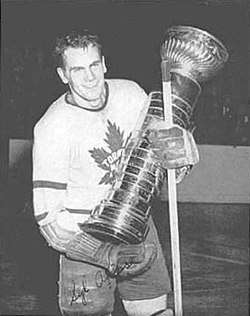
Three captains of the Maple Leafs have held the position at multiple points in their career. Syl Apps' first tenure as the captain began from 1940 to 1943, before he stepped down and left the club to enlist in the Canadian Army. Bob Davidson served as the Maple Leafs captain until Apps' return from the Army in 1945, when he resumed his captaincy until 1948.[256] Ted Kennedy's first tenure as captain was from 1948 to 1955. He announced his retirement from the sport at the end of the 1954–55 season, with Sid Smith succeeding him as captain.[252] Although Kennedy missed the entire 1955–56 season, he came out of retirement to play the second half of the 1956–57 season. During that half season, Kennedy served his second tenure as the Maple Leafs' captain.[257] Darryl Sittler was the third player to have been named the team's captain twice. As a result of a dispute between Sittler and the Maple Leafs' general manager Punch Imlach, Sittler relinquished the captaincy on December 29, 1979. The dispute was resolved in the following off-season, after a heart attack hospitalized Imlach. Sittler arranged talks with Ballard to resolve the issue, eventually resuming his captaincy on September 24, 1980.[258] No replacement captain was named during the interim period.[259]
|
|
|
Head coaches
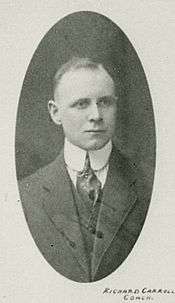
The Maple Leafs have had 40 head coaches (including four interim coaches).[252] The franchise's first head coach was Dick Carroll, who coached the team for two seasons.[252] A number of coaches have served as the Leafs head coach on multiple occasions. King Clancy was named the head coach on three separate occasions while Charles Querrie and Punch Imlach served the position on two occasions.[252] Sheldon Keefe is the current head coach. He was named coach on November 20, 2019.[260]
Punch Imlach coached the most regular season games of any Leafs' head coach with 770 games, and has the most all-time points with the Maple Leafs, with 865.[252] He is followed by Pat Quinn, who coached 574 games, with 678 points all-time with the Maple Leafs.[252] Both Mike Rodden and Dick Duff, have the fewest points with the Maple Leafs, with 0. Both were interim coaches who coached only two games each in 1927 and 1980 respectively, losing both games.[252] Mike Babcock earned the most points of any Leafs head coach in a single season, with 105 points during the 2017–18 season.[141] Five Maple Leafs' coaches have been inducted into the Hockey Hall of Fame as players, while four others were inducted as builders. Pat Burns is the only Leafs' head coach to win a Jack Adams Award with the team.[261]
Draft picks
In the 1963 NHL Amateur Draft, the NHL's inaugural draft, the Maple Leafs selected Walt McKechnie, a centre from the London Nationals with their first pick, sixth overall.[262] Two Maple Leafs captains were obtained through the draft, Darryl Sittler in the 1970 draft; as well as Wendel Clark in the 1985 NHL Entry Draft.[263] The Maple Leafs have drafted two players with a first overall draft pick; Clark in the 1985 draft, and Auston Matthews in the 2016 draft.[264] Rasmus Sandin was the most recent player selected by the Maple Leafs in the first round, using the 29th overall pick at the 2018 draft.[265]
Team and league honours
The Maple Leafs has won 13 Stanley Cups in its history.[266] Winning their last Stanley Cup in 1967, the club's 51-season Stanley Cup drought is the longest active drought in the NHL.[267] Toronto's first two Stanley Cup, in 1918 and 1922, took place when the Stanley Cup tournament operated as an interleague competition.[note 3][268] Toronto's subsequent 11 Stanley Cups were awarded after 1926, when it was established as the championship trophy of the NHL. The Maple Leafs were also awarded the Prince of Wales Trophy twice, following the 1946–47 season, and the 1962–63 season. The Prince of Wales Trophy was awarded to the club when it was used as NHL's regular season championship trophy.[note 4][269]
Retired numbers
| No. | Player | Position | Tenure | Date of honour[270] | Date of retirement[271] |
|---|---|---|---|---|---|
| 1 | Turk Broda | G | 1935–1943 1946–1951 | March 11, 1995 | October 15, 2016 |
| 1 | Johnny Bower | G | 1958–1969 | March 11, 1995 | October 15, 2016 |
| 4 | Hap Day | D | 1924–1937 | October 4, 2006 | October 15, 2016 |
| 4 | Red Kelly | C | 1960–1967 | October 4, 2006 | October 15, 2016 |
| 5 | Bill Barilko | D | 1945–1951 | Not honoured | October 17, 1992[272] |
| 6 | Ace Bailey | RW | 1926–1933 | Not honoured | February 14, 1934 |
| 7 | King Clancy | D | 1930–1937 | November 21, 1995 | October 15, 2016 |
| 7 | Tim Horton | D | 1949–1970 | November 21, 1995 | October 15, 2016 |
| 9 | Charlie Conacher | RW | 1929–1938 | February 28, 1998 | October 15, 2016 |
| 9 | Ted Kennedy | C | 1942–1955 1956–1957 | October 3, 1993 | October 15, 2016 |
| 10 | Syl Apps | C | 1936–1943 1945–1948 | October 3, 1993 | October 15, 2016 |
| 10 | George Armstrong | RW | 1949–1971 | February 28, 1998 | October 15, 2016 |
| 13 | Mats Sundin | C | 1994–2008 | February 11, 2012 | October 15, 2016 |
| 14 | Dave Keon | C | 1960–1975 | Not honoured | October 15, 2016 |
| 17 | Wendel Clark | LW | 1985–1994 1996–1998 2000 | November 22, 2008 | October 15, 2016 |
| 21 | Borje Salming | D | 1973–1989 | October 4, 2006 | October 15, 2016 |
| 27 | Frank Mahovlich | LW | 1956–1968 | October 3, 2001 | October 15, 2016 |
| 27 | Darryl Sittler | C | 1970–1982 | February 8, 2003 | October 15, 2016 |
| 93 | Doug Gilmour | C | 1992–1997 | January 31, 2009 | October 15, 2016 |
| Player elected to the Hockey Hall of Fame |
| Number retired for multiple players |
| Number was not honoured before being retired |
The Maple Leafs have retired the numbers of 19 players (as some players used the same number, only 13 numbers have been retired).[271] Between October 17, 1992, and October 15, 2016, the Maple Leafs took a unique approach to retired numbers. Whereas players who suffered a career ending injury had their numbers retired, "great" players had their number "honoured".[272] Honoured numbers remained in general circulation for players, however, during Brian Burke's tenure as the Maple Leafs' general manager, use of honoured numbers required his approval.[273]
During this period, only two players met the criteria, the first being number 6, worn by Ace Bailey and retired on February 14, 1934; and Bill Barilko's number 5, retired on October 17, 1992.[272] The retirement of Bailey's number holds the distinction of being the first of its kind in professional sports.[274][275] It was briefly taken out of retirement, after Bailey asked that Ron Ellis be allowed to wear his number.[276] Bailey's number returned to retirement after Ellis's final game on January 14, 1981.[277]
The first players to have their numbers honoured were Syl Apps and Ted Kennedy, on October 3, 1993.[272] Mats Sundin was the last player to have his number honoured on February 11, 2012.[278] On October 15, 2016, before the home opening game of the team's centenary season, the Maple Leafs announced they had changed their philosophy on retiring numbers, and that the numbers of those 16 honoured players would now be retired, in addition to the retirement of Dave Keon's number.[271]
As well as honouring and retiring the numbers, the club also commissioned statues of former Maple Leafs. The group of statues, known as Legends Row, is a 9.2 metres (30 ft) granite hockey bench with statues of former club players. Unveiled in September 2014, it is located outside Gate 5 of Scotiabank Arena, at Maple Leaf Square.[279] As of October 2017, statues have been made of 14 players with retired numbers.[280]
In addition to the 13 numbers retired by the Maple Leafs, the number 99 is also retired from use in the organization. At the 2000 NHL All-Star Game hosted in Toronto, the NHL announced the League-wide retirement of Wayne Gretzky's number 99, retiring it from use throughout all its member teams, including the Maple Leafs.[281]
Hall of Famers
The Toronto Maple Leafs acknowledge an affiliation with 75 inductees of the Hockey Hall of Fame.[282][283] The 75 inductees include 62 former players as well as 13 builders of the sport. The Maple Leafs have the greatest number of players inducted in the Hockey Hall of Fame of any NHL team.[284] The 13 individuals recognized as builders of the sport include former Maple Leafs broadcasters, executives, head coaches, and other personnel relating to the club's operations. Inducted in 2017, Dave Andreychuk was the latest Maple Leafs player to be inducted in the Hockey Hall of Fame.[285]
In addition to players and builders, five broadcasters for the Maple Leafs were also awarded the Foster Hewitt Memorial Award from the Hockey Hall of Fame.[286] In 1984, Foster Hewitt, a radio broadcaster, was awarded the Hall of Fame's inaugural Foster Hewitt Memorial Award, an award named after Hewitt. Hewitt was already inducted as a builder in the Hall of Fame prior to the award's inception.[200] Other Maple Leafs broadcasters that received the award include Wes McKnight in 1986, Bob Cole in 2007, Bill Hewitt in 2007 and Joe Bowen in 2018.[286]
Franchise career leaders
These are the top franchise leaders in regular season points, goals, assists, points per game, games played, and goaltending wins as of the end of the 2019–20 season.[287]
- * – current Maple Leafs player
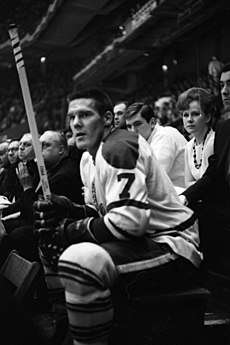
| Player | Seasons | GP | TOI | W | L | T | OT | GA | GAA | SA | SV% | SO |
|---|---|---|---|---|---|---|---|---|---|---|---|---|
| Turk Broda | 1935–1943 1946–1951 | 629 | 38,167 | 302 | 224 | 101 | — | 1,609 | 2.53 | — | — | 62 |
| Johnny Bower | 1958–1969 | 475 | 27,396 | 219 | 160 | 79 | — | 1,139 | 2.49 | 14,607 | .922 | 32 |
| Felix Potvin | 1991–1999 | 369 | 21,641 | 160 | 149 | 49 | — | 1,026 | 2.87 | 11,133 | .908 | 12 |
| Curtis Joseph | 1998–2002 | 270 | 15,808 | 138 | 97 | 28 | — | 656 | 2.49 | 7,257 | .910 | 17 |
| Frederik Andersen* | 2016–present | 244 | 14,205 | 136 | 66 | — | 33 | 656 | 2.77 | 7,798 | .916 | 13 |
| Mike Palmateer | 1976–1984 | 296 | 16,868 | 129 | 112 | 41 | — | 964 | 3.43 | 8,886 | .849 | 15 |
| Harry Lumley | 1952–1956 | 267 | 16,007 | 103 | 106 | 58 | — | 586 | 2.20 | 1,696[note 5] | .907[note 5] | 34 |
| Lorne Chabot | 1928–1933 | 215 | 13,126 | 103 | 79 | 31 | — | 475 | 2.17 | — | — | 31 |
| John Ross Roach | 1921–1928 | 222 | 13,674 | 98 | 107 | 17 | — | 639 | 2.80 | — | — | 13 |
| Ed Belfour | 2002–2006 | 170 | 10,079 | 93 | 61 | 11 | 4 | 422 | 2.51 | 4,775 | .912 | 17 |
See also
References
Footnotes
- The Presidents' Trophy was not introduced until 1985. Had the trophy existed since league inception, the Maple Leafs franchise would have won six Presidents' Trophies. The winning seasons would have included 1917–18, 1920–21, 1933–1934, 1934–35, 1947–48, and 1962–63
- Three individuals have served two separate tenures as team captain.
- The 1918 Stanley Cup playoffs included teams from the NHL, and the PCHL. The 1922 Stanley Cup playoffs included teams from the NHL, as well as the PCHA and WCHL.
- The Prince of Wales Trophy was used as the NHL's regular season championship trophy from the 1938–39 season to the 1966–67 season.
- Shots and save percentage data from 1955–56 season onwards
Citations
- "History". TorontoMapleLeafs.com. NHL Enterprises, L.P. Retrieved June 13, 2019.
The team colours are navy blue and white.
- Ledra, Cristina; Pickens, Pat (November 22, 2016). "NHL team nicknames explained". NHL.com. NHL Enterprises, L.P. Retrieved June 13, 2019.
Conn Smythe bought the Toronto St. Pats in 1927 after the franchise almost had been sold to a group in Philadelphia. He immediately changed the name of the team to the Maple Leafs to honor Canada's soldiers who wore the Maple Leaf while fighting during World War I. "We chose it ... hoping that the possession of this badge would mean something to the team that wore it and when they skated out on the ice with this badge on their chest ... they would wear it with honor and pride and courage, the way it had been worn by the soldiers of the first Great War in the Canadian Army," said Smythe, who also changed the team's colors from green and white to blue and white.
- "CRTC Approves Sale Of Maple Leaf Sports And Entertainment To Bell And Rogers |". Allaccess.com. August 17, 2012. Archived from the original on January 8, 2014. Retrieved January 8, 2014.
- "Dynasties". Hockey Hall of Fame and Museum. 2017. Archived from the original on July 16, 2017. Retrieved July 11, 2017.
- "Stanley Cup Dynasties". National Hockey League. Archived from the original on April 28, 2016. Retrieved July 11, 2017.
- Shea & Wilson 2016, p. 7.
- Holzman & Nieforth 2002, p. 151.
- Holzman & Nieforth 2002, p. 159.
- Hunter, Douglas (1997). Champions: The Illustrated History of Hockey's Greatest Dynasties. Chicago: Triumph Books. pp. 18–19. ISBN 1-5724-3213-6.
- Holzman & Nieforth 2002, p. 193.
- Morrison, John; McLatchy, Doug (1996). The Toronto Blue Shirts a.k.a. The Torontos, the NHL's First Stanley Cup Champions 1917–1918. Hockey Information Service Inc. ISBN 1-8940-1400-6.
- "How one cantankerous man inspired the creation of the NHL". TVO. The Ontario Educational Communications Authority. December 19, 2017. Archived from the original on February 3, 2018. Retrieved February 1, 2018.
- Shea & Wilson 2016, p. 13–14.
- Shea & Wilson 2016, p. 10.
- Holzman & Nieforth 2002, p. 197.
- Holzman & Nieforth 2002, p. 199.
- "History - 1920s". National Hockey League. Archived from the original on March 29, 2018. Retrieved May 31, 2018.
- Shea & Wilson 2016, p. 15.
- Shea & Wilson 2016, p. 15–16.
- Shea & Wilson 2016, p. 20.
- "Builders - J. P. Bickell - Biography". Hockey Hall of Fame. Archived from the original on August 19, 2017. Retrieved August 19, 2017.
- Shea & Wilson 2016, p. 30–31.
- Shea & Wilson 2016, p. 33.
- Proteau, Adam (February 19, 2016). "Deep Ties Between the Maple Leafs and Canadian Armed Forces". National Hockey League. Archived from the original on July 16, 2017. Retrieved April 22, 2017.
- Smythe, Thomas Stafford; Shea, Kevin (2000). Centre Ice: The Smythe Family, the Gardens and the Toronto Maple Leafs Hockey Club. Fenn Publishing. p. 36. ISBN 1-5516-8250-8.
- Brockbank, Nicole (October 14, 2016). "The original Maple Leafs: Pro-baseball in Toronto before the Blue Jays". CBCNews.ca. Canadian Broadcasting Corporation. Archived from the original on December 3, 2016. Retrieved January 29, 2018.
- "Good-bye St. Pats, howdy Maple Leafs", The Globe, February 15, 1927, p. 6.
- "Toronto crumbles New York chances", The Globe, February 18, 1927, p. 8.
- Shea & Wilson 2016, p. 35.
- Baute, Nicole (November 12, 2008). "The colour of Toronto". Toronto Star. Torstar Corporation. Archived from the original on January 29, 2018. Retrieved January 29, 2018.
- Shea & Wilson 2016, p. 45.
- Shea & Wilson 2016, p. 47–48.
- "Toronto Maple Leafs History - 1930s". Maple Leafs Sports & Entertainment. Retrieved June 21, 2017.
- "48th Highlanders of Canada Pipe and Drums". Canadian Armed Forces. 2018. Archived from the original on August 22, 2018. Retrieved August 21, 2018.
- Hornby, Lance (October 16, 2016). "Highlanders ready for Maple Leafs' home opener". Toronto Sun. Postmedia Network. Archived from the original on August 21, 2018. Retrieved August 21, 2018.
- "Memorial service held in Toronto for hockey legend Johnny Bower". Global News. Corus Entertainment. January 2, 2018. Archived from the original on June 15, 2018. Retrieved August 21, 2018.
- "The press gondola at Maple Leaf Gardens". CBC Digital Archives. Canadian Broadcasting Corporation. 2018. Archived from the original on January 24, 2018. Retrieved February 2, 2018.
- Shea & Wilson 2016, p. 52–53.
- McParland, Kelly (2012). The Lives of Conn Smythe: From the Battlefield to Maple Leaf Gardens: A Hockey Icon's Story. McClelland & Stewart. p. 138. ISBN 0-7710-5684-2.
- Shea & Wilson 2016, p. 60.
- Shea & Wilson 2016, p. 63.
- Shea & Wilson 2016, p. 83–84.
- Shea & Wilson 2016, p. 84.
- "Hall of Flameout: The 25 worst collapses in sports history". ESPN. June 12, 2016. Archived from the original on July 16, 2017. Retrieved June 22, 2017.
- Shea & Wilson 2016, p. 81.
- Shea & Wilson 2016, p. 80.
- "Toronto Maple Leafs History - 1940s". Maple Leafs Sports & Entertainment. Retrieved June 22, 2017.
- Shea & Wilson 2016, p. 86–87.
- Shea & Wilson 2016, p. 107.
- "Toronto Maple Leafs History - 1950s". Maple Leafs Sports & Entertainment. Retrieved June 22, 2017.
- Shea & Wilson 2016, p. 123.
- Pagan, Ken (October 20, 2011). "Barilko's plane finally arrives home". Toronto Sun. Postmedia Network Inc. Archived from the original on August 3, 2017. Retrieved June 22, 2017.
- Gudgeon, Christopher (2017). The Sound of One Team Sucking: Mindful Meditations for Recovering Leafs Fans. Dundurn. p. 106. ISBN 1-4597-3836-5.
- "Toronto Maple Leafs History - 1960s". Maple Leafs Sports & Entertainment. 2017. Retrieved June 25, 2017.
- Shea & Wilson 2016, p. 142.
- Smythe & Young 1981, p. 217–218.
- Shea & Wilson 2016, p. 158.
- Shea & Wilson 2016, p. 183.
- McKee, Ken (March 8, 1966). "'Cash rated over class' Conn quits". Toronto Star.
- Shea & Wilson 2016, p. 161–162.
- Shea & Wilson 2016, p. 173.
- Shea & Wilson 2016, p. 194.
- Shea & Wilson 2016, p. 195.
- Shea & Wilson 2016, p. 200.
- Shea & Wilson 2016, p. 205.
- McAuliffe, Bill (July 1, 2008). The Story of the Toronto Maple Leafs. The Creative Company. ISBN 978-1-58341-621-1.
- Shea & Wilson 2016, p. 208.
- "Maple Leafs History - 1970s". Maple Leafs Sports & Entertainment. Archived from the original on April 27, 2019. Retrieved June 27, 2017.
- Podnieks, Andrew (2015). The Toronto Maple Leafs Ultimate Book of Facts, Stats, and Stories. McClelland & Stewart. p. 90. ISBN 0-7710-7222-8.
- Shea & Wilson 2016, p. 212.
- Beddoes, Dick (January 5, 1972). "MLG control at stake: Smythe bid for Ballard stock rejected". The Globe and Mail.
- Orr, Frank (February 5, 1972). "Harrold Ballard: From rink rat to Gardens' boss". Toronto Star.
- Dunnell, Milt (February 4, 1972). "Ballard buys Gardens control for $7,546,350". Toronto Star.
- Lutsky, Irvin (February 5, 1972). "Gardens' president Harold Ballard to buy Smythe shares". The Globe and Mail.
- Shea & Wilson 2016, p. 217.
- Shea & Wilson 2016, p. 233.
- Shea & Wilson 2016, p. 238.
- Kernaghan, Jim (December 29, 1979). "Lanny McDonald trade has Sittler in tears". Toronto Star. p. 1.
- "Maple Leafs History - 1980s". Maple Leafs Sports & Entertainment. Retrieved June 27, 2017.
- Shea & Wilson 2016, p. 247.
- Shea & Wilson 2016, p. 248.
- Shea & Wilson 2016, p. 239.
- Shea & Wilson 2016, p. 253–254.
- Shea & Wilson 2016, p. 275.
- Shea & Wilson 2016, p. 278.
- Shea & Wilson 2016, p. 280.
- Cox, Damien; Stellick, Gord (2004). '67, The Maple Leafs: Their Sensational Victory and the End of an Empire. Wiley. p. 12. ISBN 0-470-83400-5.
- "Maple Leafs History - 1990s". Maple Leafs Sports & Entertainment. Retrieved June 27, 2017.
- Zwolinski, Mark (April 29, 2013). "Maple Leafs in playoffs: 1992-'93 defence similar to this year's, says Todd Gill". Toronto Star. Torstar Corporation. Archived from the original on January 29, 2018. Retrieved January 29, 2018.
- Zeisberger, Mike (April 7, 2007). "Better than a Game 7: Hockey icons' true colours show through". Canoe.com. Archived from the original on July 20, 2012. Retrieved June 28, 2008.
- Tedesco, Theresa (February 13, 1998). "Raptors bought by Leafs". The Hamilton Spectator. Torstar Corp.
- Shea & Wilson 2016, p. 302.
- Jozsa Jr, Frank P (2017). National Basketball Association Franchises: Team Performance and Financial Success. Lexington Books. p. 32. ISBN 1-4985-4800-8.
- Grange, Michael (February 24, 2004). "What does winning look like?". The Globe and Mail. The Woodbridge Company. Archived from the original on June 5, 2016. Retrieved March 30, 2018.
- "Lawrence Tanenbaum, OC". Kilmer Group. 2018. Archived from the original on March 30, 2018. Retrieved March 30, 2018.
- Shea & Wilson 2016, p. 303–304.
- Shea & Wilson 2016, p. 307.
- Shea & Wilson 2016, p. 309.
- Shea & Wilson 2016, p. 311.
- Hoffman, Patrick (February 4, 2013). "A look back at the 2002 East final". Sportsnet. Rogers Digital Media. Retrieved February 27, 2020.
- Leonetti 2014, p. 218.
- Devellano, Jim; Lajoie, Roger (2010). The Road to Hockeytown: Jimmy Devellano's Forty Years in the NHL. John Wiley and Sons. p. 242. ISBN 0-4707-3870-7.
- "Belfour, Mogilny Among Award Nominees". Toronto Maple Leafs. Maple Leafs Sports & Entertainment. April 30, 2003. Archived from the original on August 3, 2017. Retrieved June 30, 2017.
- Shea & Wilson 2016, p. 321.
- Shoalts, David (February 12, 2003). "Leafs' front-office struggle may heat up". The Globe and Mail. Retrieved June 30, 2017.
- "Ferguson Jr., 36, hired to fill Quinn's shoes". ESPN. August 29, 2003. Archived from the original on July 16, 2017. Retrieved June 30, 2017.
- "Leafs to visit Sweden and Finland this September for Challenge 2003". Toronto Maple Leafs. Maple Leafs Sports & Entertainment. February 10, 2003. Archived from the original on August 4, 2017. Retrieved June 30, 2017.
- Mitchell, Bob (April 21, 2013). "Maple Leafs in the playoffs: Where are 2003-04 players now?". Toronto Star. Torstar Coprporation. Archived from the original on July 30, 2013. Retrieved June 30, 2017.
- Shea & Wilson 2016, p. 328.
- Staples, David (May 27, 2009). "Why Pat Quinn got fired from the Toronto Maple Leafs". The Edmonton Journal. Postmedia Network Inc. Archived from the original on August 4, 2017. Retrieved January 27, 2019.
- Simmons, Steve (February 25, 2012). "Ferguson's Leafs were better than Burke's". Toronto Sun. Postmedia Network Inc. Archived from the original on August 3, 2017. Retrieved June 30, 2017.
- Shea & Wilson 2016, p. 327.
- "Maple Leafs cut Belfour, Domi". Canadian Broadcasting Corporation. June 30, 2006. Retrieved June 30, 2017.
- Shea & Wilson 2016, p. 328–29.
- Milner, Brian (January 23, 2008). "Toronto sports lawyer begins new Leafs GM search". The Globe and Mail. Archived from the original on May 2, 2019. Retrieved May 2, 2019.
- "Maple Leafs eliminated from playoff contention". CTV News Toronto. March 28, 2008. Archived from the original on August 3, 2017. Retrieved June 30, 2017.
- "Leafs' Sundin won't waive no-trade clause - Hockey - CBC". Canadian Broadcasting Corporation. February 24, 2008. Archived from the original on March 17, 2011. Retrieved January 8, 2014.
- "Maple Leafs fire head coach Paul Maurice". TSN. May 7, 2008. Archived from the original on May 10, 2008. Retrieved May 7, 2008.
- "Leafs introduce Burke as new president and general manager". TSN. November 29, 2008. Archived from the original on June 6, 2011. Retrieved January 21, 2009.
- "Nazem Kadri drafted by Leafs". PensionPlanPuppets. Archived from the original on March 28, 2012. Retrieved August 16, 2011.
- "Kessel traded to Maple Leafs, signs 5-year, $27m contract". TSN. September 19, 2009. Archived from the original on April 20, 2010.
- "FLAMES TRADE D PHANEUF TO MAPLE LEAFS IN SEVEN-PLAYER DEAL". The Sports Network. January 31, 2010. Archived from the original on February 3, 2010. Retrieved January 31, 2010.
- "Maple Leafs introduce Phaneuf as team's captain". CTV.com. June 14, 2010. Archived from the original on July 27, 2011. Retrieved June 14, 2010.
- "Tomas Kaberle Traded to Boston; Bruins Trade Blake Wheeler to Atlanta". AOL. February 18, 2011. Archived from the original on May 16, 2011. Retrieved June 21, 2011.
- Cox, Damien (March 2, 2012). "Ron Wilson fired: Leafs turn to Randy Carlyle". Toronto Star. Torstar Corporation. Archived from the original on October 31, 2015. Retrieved July 8, 2017.
- Shecter, Barbara (August 22, 2012). "Teachers' completes $1.32-billion MLSE sale to Rogers, Bell". Financial Post. Postmedia Network Inc. Archived from the original on July 6, 2017. Retrieved July 19, 2017.
- "Maple Leafs Replace Burke With Nonis As New GM". TSN. January 9, 2013. Archived from the original on January 9, 2013. Retrieved January 9, 2013.
- Shea & Wilson 2016, p. 341–42.
- Dimanno, Rosie (April 8, 2014). "Maple Leafs officially eliminated from the playoffs". Toronto Star. Torstar Corporation. Archived from the original on October 1, 2015. Retrieved June 30, 2017.
- "Brendan Shanahan Named Leafs President & Alternate Governor". TorontoMapleLeafs.com. NHL Enterprises, L.P. Archived from the original on April 14, 2014. Retrieved July 25, 2014.
- Whyno, Stephen (January 6, 2015). "Ten candidates to replace Randy Carlyle as next coach of Maple Leafs". The Globe and Mail. Archived from the original on January 16, 2015. Retrieved June 29, 2017.
- Kelly, Cathal (February 12, 2015). "Shanahan's scorched-earth Leafs plan wins MLSE support". The Globe and Mail. Archived from the original on March 11, 2017. Retrieved June 29, 2017.
- "Maple Leafs announce organizational changes". Toronto Maple Leafs. April 12, 2015. Archived from the original on April 15, 2015. Retrieved April 12, 2015.
- "Maple Leafs announce changes to scouting staff". Toronto Maple Leafs. April 12, 2015. Archived from the original on July 23, 2015. Retrieved July 22, 2015.
- "Mike Babcock hired by Maple Leafs as coach". National Hockey League. May 20, 2015. Archived from the original on July 23, 2015. Retrieved July 22, 2015.
- "Lamoriello named Maple Leafs GM". The Sports Network. July 23, 2015. Archived from the original on July 23, 2015. Retrieved July 23, 2015.
- Johnston, Mike (July 1, 2015). "Maple Leafs trade Phil Kessel to Penguins". Sportsnet. Rogers Digital Media. Archived from the original on September 9, 2015. Retrieved September 20, 2015.
- "2015–16 NHL Trade Tracker". National Hockey League. Archived from the original on March 31, 2016. Retrieved March 28, 2016.
- "Maple Leafs select Auston Matthews with first pick in 2016 NHL Draft". Sportsnet. Rogers Digital Media. June 24, 2016. Archived from the original on November 2, 2016. Retrieved June 29, 2017.
- "Washington Capitals - Toronto Maple Leafs - April 23rd, 2017". National Hockey League. April 23, 2017. Archived from the original on April 24, 2017. Retrieved April 23, 2017.
- "Maple Leafs set two team records in win against Canadiens". National Hockey League. April 7, 2018. Archived from the original on April 8, 2018. Retrieved April 8, 2018.
- Goss, Nicholas (April 25, 2018). "Bruins Wrap: Jake DeBrusk Scores Twice, B's Beat Leafs 7-4 In Game 7 Thriller". NESN.com. Archived from the original on April 26, 2018. Retrieved April 26, 2018.
- "Lamoriello will not return as Leafs GM - Article - TSN". TSN. April 30, 2018. Archived from the original on May 2, 2018. Retrieved May 11, 2018.
- "Toronto Maple Leafs appoint 32-year-old Kyle Dubas as general manager". The Globe and Mail Inc. May 11, 2018. Archived from the original on May 14, 2018. Retrieved September 18, 2018.
- Compton, Brian (July 1, 2018). "Tavares signs seven-year contract with Maple Leafs". National Hockey League. Archived from the original on July 12, 2018. Retrieved September 18, 2018.
- "Maple Leafs clinch playoff spot with win over Islanders". Sportsnet. Rogers Digital Media. April 1, 2019. Archived from the original on April 6, 2019. Retrieved May 7, 2019.
- Wharnsby, Tim (April 23, 2019). "Leafs face another long summer of second-guessing after devastating Game 7 loss". CBC Sports. Canadian Broadcasting Corporation. Archived from the original on May 6, 2019. Retrieved May 7, 2019.
- Clipperton, Joshua (October 2, 2019). "NHL·New Toronto native John Tavares named captain of Maple Leafs". CBC News. Canadian Broadcasting Corporation. Retrieved October 2, 2019.
- "Maple Leafs fire head coach Mike Babcock". Sportsnet. Rogers Digital Media. November 20, 2019. Retrieved November 23, 2019.
- Lawrence, Jesse (September 14, 2015). "Maple Leafs Have Most Expensive NHL Tickets For 2014-15 Season". Forbes. Forbes Media LLC. Archived from the original on February 8, 2018. Retrieved February 8, 2018.
- McGran, Kevin (November 16, 2016). "Maple Leafs boast league's most expensive ticket on resale market". Toronto Star. Torstar Corporation. Archived from the original on February 9, 2018. Retrieved February 8, 2018.
- Keller, Tony (March 17, 2017). "Why are NHL tickets expensive in Toronto? Because they're cheap in Phoenix". The Globe and Mail. Phillip Crawl. Archived from the original on June 9, 2017. Retrieved February 8, 2018.
- Donnelly, Aileeon (June 9, 2016). "Heir to millions loses fight for Maple Leafs season tickets after judge rules they belong to father's company". National Post. Postmedia Network Inc. Retrieved June 8, 2017.
- "Toronto Maple Leafs are the worst sports franchise in North America, according to ESPN". National Post. Canada. September 19, 2014. Archived from the original on April 2, 2015. Retrieved April 2, 2015.
- Leonetti 2014, p. 1.
- Toth, Mike (September 13, 2009). "Leaf fans deserve more". Sportsnet. Rogers Digital Media. Retrieved February 27, 2020.
- Holroyd, Caitlyn (March 9, 2017). "Look: Which NHL fan base is the most loyal?". The Score. Score Media Ventures Inc.
- "Sabres still searching for new owner". CBC Sports. November 17, 2002. Archived from the original on May 11, 2008. Retrieved May 1, 2008.
- Hornby, Lance (March 3, 2012). "Fire Wilson Chant was last straw". Toronto Sun. Postmedia Network Inc. Archived from the original on August 3, 2017. Retrieved July 8, 2017.
- Blair, Jeff (March 20, 2012). "Leafs fans now chant 'Fire Burkie'". The Globe and Mail. Archived from the original on March 1, 2014. Retrieved July 9, 2017.
- Zwolinski, Mark (January 20, 2015). "Three fans charged after Maple Leafs jerseys tossed on ice". Toronto Star. Torstar Corporation. Archived from the original on November 18, 2015. Retrieved July 9, 2017.
- "Leafs fans: 'Let's go, Blue Jays!'". Sportsnet.ca. Archived from the original on March 14, 2016. Retrieved February 3, 2016.
- "Leaf Nation turns its back on Toronto Maple Leafs". Toronto Star. March 20, 2012. Archived from the original on January 24, 2015. Retrieved February 3, 2016.
- "Toronto Maple Leafs look like a different team under Mike Babcock despite season-opening loss to Montreal Canadiens". National Post. Archived from the original on February 3, 2016. Retrieved February 3, 2016.
- "Leafs fans vandalizing Wikipedia keep editors hopping". thestar.com. December 1, 2019.
- Rice, Waubgeshig (May 2, 2017). "Leafs, Habs fans in Ottawa jump on Senators bandwagon — for now". CBC News Ottawa. Canadian Broadcasting Corporation. Archived from the original on May 5, 2017. Retrieved December 5, 2017.
- "Red Wings target Canadian fans in southern Ontario". CBCNews.ca. Canadian Broadcasting Corporation. September 30, 2013. Archived from the original on December 26, 2016. Retrieved July 9, 2017.
- "Hockey series creates divided loyalties". CBCNews.ca. Canadian Broadcasting Corporation. November 10, 2000. Retrieved July 9, 2017.
- Spears, Tony (February 13, 2013). "Ottawa Senators move to keep Toronto Maple Leafs fans out of the Bank". The Ottawa Sun. Postmedia Network Inc. Archived from the original on August 3, 2017. Retrieved July 9, 2017.
- Goods, Jack (June 24, 2016). "Maple Leafs fans fill up First Niagara Center for NHL Draft". The Buffalo News. Archived from the original on August 3, 2017. Retrieved July 9, 2017.
- Opler, Lorne (January 30, 2016). "Shuffle off to Buffalo to watch the Leafs". The Hamilton Spectator. Archived from the original on August 3, 2017. Retrieved July 9, 2017.
- Betts, Sarah (January 5, 2017). "Canadiens edge the Maple Leafs as Atlantic Canada's favourite NHL team". CBCNews.ca. Canadian Broadcasting Corporation. Archived from the original on January 7, 2017. Retrieved July 9, 2017.
- Allen, Kevin (2014). 100 Things Red Wings Fans Should Know & Do Before They Die. Triumph Books. pp. 212–215. ISBN 1-6236-8982-1.
- Zweig, Eric (2010). Twenty Greatest Hockey Goals. Dundurn Press. p. 61. ISBN 978-1-55488-789-7.
- Willis, Jonathan (April 7, 2015). "Maple Leafs-Senators rivalry really one-sided". Sportsnet. Rogers Digital Media. Archived from the original on March 22, 2016. Retrieved July 14, 2017.
- "Bruins rally from 4-1 deficit to eliminate Leafs in Game 7". The Sports Network. May 14, 2013. Archived from the original on June 7, 2013. Retrieved April 28, 2019.
- Kalman, Matt (April 25, 2018). "Bruins advance with Game 7 win against Maple Leafs". National Hockey League. Archived from the original on April 26, 2018. Retrieved April 26, 2018.
- Kalman, Matt (April 23, 2019). "Bruins win Game 7, eliminate Maple Leafs". National Hockey League. Archived from the original on April 24, 2019. Retrieved April 23, 2019.
- Kreiser, John (April 15, 2011). "Canadiens, Bruins are NHL's longest playoff rivalry". National Hockey League. Archived from the original on April 16, 2011. Retrieved April 15, 2011.
- LeafsPR 2016, p. 399–401.
- LeafsPR 2016, p. 401–403.
- LeafsPR 2016, p. 404–406.
- LeafsPR 2016, p. 418.
- Vaswani, Navin (December 31, 2016). "Remembering '93, when the Maple Leafs stunned the Red Wings". The Score. Score Media Ventures.
- Rosen, Dan (December 5, 2011). "Governors adopt radical four-conference realignment plan". National Hockey League. Archived from the original on December 6, 2011. Retrieved December 5, 2011.
- Clipperton, Joshua (January 31, 2017). "NHL 100: Canadiens-Maple Leafs among heated rivalries". Canadian Broadcasting Corporation. Archived from the original on April 20, 2017. Retrieved July 14, 2017.
- O'Connor, Joe (April 6, 2012). "Canadiens versus Leafs: Two rivals meet again, but they've changed". National Post. Postmedia Network Inc. Retrieved July 14, 2017.
- Shoalts, David (December 3, 1997). "Leafs get wish to play Habs more". The Globe and Mail. p. S1.
- Lowrie, Morgan (December 24, 2016). "Carrier's 'The Hockey Sweater' still captivates, 70 years after winter of 1946". Global News. Corus Entertainment Inc. Archived from the original on January 29, 2017. Retrieved July 14, 2017.
- Wise, Leonard (2017). Charles Pachter: Canada's Artist. Dundurn. ISBN 1-4597-3875-6.
- "Senators try to shut Leafs fans out of Scotiabank Place". CTVNews.ca. Bell Media. February 14, 2013. Archived from the original on August 3, 2017. Retrieved July 9, 2017.
- "Part II -- Top rivalries". ESPN. September 29, 2005. Archived from the original on August 3, 2017. Retrieved July 14, 2017.
- "Leafs Announce 2014–15 TV & Radio Broadcast Schedule". Toronto Maple Leafs. Archived from the original on October 18, 2014. Retrieved October 11, 2014.
- "Sep 12, 2019 TSN Delivers 26 Regular Season Toronto Maple Leafs Games as Part of 2019-20 Regional NHL Broadcast". TSN. BellMedia. September 19, 2019. Retrieved October 20, 2019.
- "Sportsnet releases 2019-20 Toronto Maple Leafs broadcast schedule". Sportsnet. Rogers Digital Media. September 12, 2019. Retrieved October 20, 2019.
- "Canada's Walk of Fame Honours Maple Leaf Sports & Entertainment with Inaugural 'Friend of Canada's Walk of Fame' Distinction". Cision. CNW Group Ltd. November 16, 2017. Archived from the original on December 1, 2017. Retrieved November 28, 2017.
- "Marlies Games Coming to NHL Network in United States". Toronto Marlies. October 8, 2017. Archived from the original on January 29, 2018. Retrieved January 29, 2018.
- Shoalts, David (2018). Hockey Fight in Canada: The Big Media Faceoff over the NHL. Douglas & McIntyre. ISBN 1-7716-2205-9.
- Leonetti 2014, p. 160–161.
- Kevin Shea, ed. (November 9, 2007). "One on One with Foster Hewitt". Hockey Hall of Fame and Museum. Archived from the original on June 30, 2016. Retrieved July 7, 2017.
- Young, Peter (2002). Let's Dance. Natural Heritage/Natural History Inc. p. 23. ISBN 1-896219-02-0.
- Filey, Mike (2008). Toronto: The Way We Were. Dundurn Press. p. 225. ISBN 978-1-55002-842-3.
- "Arena Gardens". Heritage Toronto. March 6, 2016. Archived from the original on January 6, 2017. Retrieved July 7, 2017.
- Brenda Patterson, General Manager, Parks, Forestry and Recreation (May 4, 2011). "Proposed renaming of Cathedral Square Park to 'Arena Gardens'" (PDF). Staff Report. City of Toronto. Archived (PDF) from the original on October 16, 2012. Retrieved August 10, 2011.CS1 maint: multiple names: authors list (link)
- Boccia, Erica (November 29, 2013). "Maple Leaf Gardens". Heritage Toronto. Archived from the original on May 11, 2017. Retrieved July 7, 2017.
- Shubert, Howard (2016). Architecture on Ice: A History of the Hockey Arena. McGill-Queen's University Press. pp. 95–96. ISBN 0-7735-4813-0.
- Podnieks, Andrew (2000). NHL All-star Game: 50 Years of the Great Tradition. HarperCollins Publishers. p. 23. ISBN 0-0020-0058-X.
- Flavelle, Dana (November 25, 2011). "Maple Leaf Gardens: From Shrine to Supermarket". Toronto Star. Archived from the original on November 28, 2011. Retrieved November 25, 2011.
- "Mattamy Athletic Centre - Venue Info". Mattamy Athletic Centre. Archived from the original on December 22, 2013. Retrieved January 22, 2014.
- "History". Air Canada Centre. Archived from the original on June 13, 2011. Retrieved April 21, 2012.
- "Facts - The Air Canada Centre". Maple Leafs Sports & Entertainment. Archived from the original on June 15, 2017. Retrieved July 7, 2017.
- Doolittle, Robyn; Rider, David (June 21, 2011). "Lakeshore Lions Arena rescued, city backtracks on naming rights". Toronto Star. Torstar Corporation. Archived from the original on August 3, 2017. Retrieved July 7, 2017.
- "Mastercard Centre for Hockey Excellence". Lakeshore Arena Corporation. 2017. Archived from the original on July 10, 2017. Retrieved July 7, 2017.
- Siegel, Jonas (January 2, 2017). "Centennial Classic lives up to billing as Leafs down Red Wings in OT". CBC Sports. Canadian Broadcasting Corporation. Archived from the original on March 5, 2019. Retrieved January 4, 2019.
- Paul Hunter (June 14, 2010). "Leafs' new look is a bit old-school". Toronto Star. Archived from the original on November 24, 2011. Retrieved September 6, 2011.
- "Leafs Unveil Uniform For Centennial Classic". Toronto Maple Leafs. Maple Leaf Sports & Entertainment. November 21, 2016. Archived from the original on August 3, 2017. Retrieved July 9, 2017.
- Obodiac 1976, p. 202.
- LeafsPR 2016, p. 364.
- Obodiac 1976, p. 212.
- LeafsPR 2016, p. 365.
- LeafsPR 2016, p. 366.
- LeafsPR 2016, p. 367.
- "Maple Leafs Unveil New Logo". Toronto Maple Leafs. February 2, 2016. Archived from the original on February 6, 2016. Retrieved February 3, 2016.
- "Leafs unveil new logo for 2016–17". The Sports Network. February 2, 2016. Archived from the original on June 21, 2016. Retrieved June 26, 2016.
- "Toronto Maple Leafs unveil new uniforms at 2016 NHL Draft". Toronto Maple Leafs. June 24, 2016. Archived from the original on June 28, 2016. Retrieved June 26, 2016.
- Shea & Wilson 2016, p. 294–295.
- "Toronto Maple Leafs Centennial Timeline". Toronto Maple Leafs. 2018. Archived from the original on April 5, 2018. Retrieved April 5, 2018.
- "Marlies Timeline". Toronto Marlies. 2018. Archived from the original on February 28, 2018. Retrieved February 28, 2018.
- Ballou, Bill (April 4, 2013). "AHL: Bracken Kearns easy Worcester Sharks MVP choice". Telegram & Gazette. Archived from the original on March 4, 2018. Retrieved March 4, 2018.
- "AHL History". Toronto Marlies. 2018. Archived from the original on March 4, 2018. Retrieved March 4, 2018.
- "Marlies History". Toronto Marlies. Archived from the original on February 28, 2018. Retrieved February 28, 2018.
- "Maple Leafs announce Newfoundland Growlers as new ECHL affiliate". Sportsnet.ca. Archived from the original on June 15, 2018. Retrieved June 14, 2018.
- "Toronto Maple Leafs". Forbes. Forbes Media LLC. December 2018. Archived from the original on November 16, 2018. Retrieved December 12, 2018.
- McGran, Kevin (November 29, 2012). "NHL lockout: Maple Leafs worth a billion says Forbes". Toronto Star. Torstar Corporation. Archived from the original on May 17, 2019. Retrieved May 17, 2019.
- Shea & Wilson 2016, p. 6.
- Shea & Wilson 2016, p. 13.
- Shea & Wilson 2016, p. 16.
- "Defense Star Leads "Pros"". The Globe. December 9, 1919. p. 9.
- Smythe & Young 1981, p. 104–106.
- Dunnell, Milt (July 5, 1965). "Baseball's bankroll gone". Toronto Star.
- Hunter, Douglas (1997). Champions: The Illustrated History of Hockey's Greatest Dynasties. Chicago, Illinois: Triumph Books. p. 50. ISBN 1-57243-213-6.
- "Smythe is elected Gardens' president". Toronto Daily Star. November 20, 1947.
- "Stavro set to take Gardens private Meeting seen as a 'rubber stamp'". Toronto Star. August 6, 1996.
- Van Alphen, Tony (May 3, 1994). "Stavro set to take Gardens private". Toronto Star.
- Mangan, J. A.; Staudohar, Paul D., eds. (1991). The Business of Professional Sports. University of Illinois Press. pp. 203–204. ISBN 0-2520-6161-6.
- Fitz-Gerald, Sean (December 10, 2011). "What the #!%*?: Explaining the MLSE deal". National Post. Postmedia Network Inc. Retrieved July 8, 2017.
- Rocha, Euan (December 9, 2011). "Toronto sports empire sold to Rogers and BCE". Reuters. Archived from the original on March 17, 2014. Retrieved March 16, 2014.
- Fitz-Gerald, Sean (December 9, 2011). "MLSE deal: What Rogers and Bell buyout means for fans". National Post. Postmedia Network Inc. Retrieved July 8, 2017.
- "Bell to keep Canadiens stake". Canadian Broadcasting Corporation. The Canadian Press. December 9, 2011. Archived from the original on September 26, 2013. Retrieved December 10, 2011.
- "Toronto Maple Leafs Roster". National Hockey League. Retrieved August 11, 2020.
- "Toronto Maple Leafs Roster Transactions". The Sports Network. Retrieved January 14, 2020.
- LeafsPR 2018, p. 175.
- "Look and "C": Leafs captains over the years". Toronto Sun. Retrieved February 27, 2020.
- Zwelling, Arden (December 18, 2013). "Greatest Maple Leafs: No. 14 George Armstrong". Sportsnet. Rogers Digital Media. Archived from the original on February 15, 2018. Retrieved January 24, 2018.
- "Sundin's extended bio". The Province. December 18, 2008. Archived from the original on January 30, 2009. Retrieved December 20, 2008.
- "One on One with Syl Apps". Hockey Hall of Fame and Museum. December 3, 2011. Archived from the original on August 3, 2017. Retrieved July 11, 2017.
- "The Ted Kennedy Story". Toronto Maple Leafs. Maple Leaf Sports & Entertainment. August 14, 2014. Archived from the original on August 4, 2017. Retrieved July 11, 2017.
- "Peace is wonderful, but ...," Frank Orr, Toronto Star, September 5, 1980, p. D1.
- LeafsPR 2016, p. 240–241.
- "Toronto Maple Leafs fire Mike Babcock". The Sports Network. BellMedia. Retrieved November 20, 2019.
- McGran, Kevin (April 25, 2017). "Maple Leafs' Mike Babcock has claim on Jack Adams Award". Toronto Star. Torstar Corporation. Archived from the original on April 25, 2017. Retrieved July 1, 2017.
- Traikos, Michael (June 23, 2012). "Ones upon a time: A history of Leafs' draft picks". National Post. Postmedia Network Inc. Retrieved July 1, 2017.
- Denault, Todd (2012). A Season in Time: Super Mario, Killer, St. Patrick, the Great One, and the Unforgettable 1992-93 NHL Season. John Wiley & Sons. pp. 11–12. ISBN 1-1181-4580-1.
- Feschuk, Dave (March 28, 2017). "Auston Matthews breaks Wendel Clark's rookie record: Feschuk". Toronto Star. Torstar Corporation. Archived from the original on February 5, 2018. Retrieved February 14, 2018.
- Feschuk, Dave (June 23, 2018). "Everything's coming up Rasmus for Maple Leafs, too". Toronto Star. Torstar Corporation. Archived from the original on June 23, 2018. Retrieved June 23, 2018.
- "Stanley Cup winners". Hockey Hall of Fame. 2015. Archived from the original on June 26, 2015. Retrieved June 14, 2015.
- Billeck, Scott (June 12, 2019). "Blues latest team erased from Stanley Cup drought list". NBC Sports. NBCUniversal. Retrieved March 24, 2020.
- "The Stanley Cup". Hockey Hall of Fame. 2015. Archived from the original on June 27, 2015. Retrieved June 14, 2015.
- "NHL Prince of Wales Trophy Winners". National Hockey League. May 24, 2018. Archived from the original on May 18, 2019. Retrieved May 18, 2019.
- LeafsPR 2016, p. 374–391.
- "Toronto Maple Leafs retire the numbers of 17 players". National Hockey League. October 15, 2016. Archived from the original on October 18, 2016. Retrieved October 16, 2016.
- Iaboni, John. "Honoured Players Process Different For Leafs". Leafs Game Day. Maple Leafs Sports & Entertainment. Archived from the original on September 15, 2016. Retrieved July 3, 2017.
- McGran, Kevin (February 11, 2012). "Maple Leafs' honoured numbers reserved for 'special players'". Toronto Star. Torstar Corporation. Archived from the original on January 29, 2018. Retrieved January 29, 2018.
- Fischler, Stan (2015). The Handy Hockey Answer Book. Visible Ink Press. p. 59. ISBN 1-5785-9567-3.
- Greene, Nick (November 7, 2014). "Who Had the First Jersey Number to Be Retired in Sports?". Mental Floss. Archived from the original on June 20, 2018. Retrieved October 28, 2017.
- Stubbs, David (October 4, 2017). "Former forward Ellis dreaming of Cup for Maple Leafs". www.nhl.com. NHL Enterprises, L.P. Retrieved February 27, 2020.
- Stubbs, Dave (October 4, 2017). "Former forward Ellis dreaming of Cup for Maple Leafs". National Hockey League. Archived from the original on January 29, 2018. Retrieved January 29, 2018.
- LeafsPR 2016, p. 391.
- LeafsPR 2016, p. 370.
- Sadler, Emily (October 6, 2017). "Maple Leafs add Clark, Mahovlich, Kelly, Conacher to Legends Row". Sportsnet. Archived from the original on October 28, 2017. Retrieved October 28, 2017.
- "Perfect setting: Gretzky's number retired before All-Star Game". CNN Sports Illustrated. Associated Press. February 6, 2000. Archived from the original on November 12, 2013. Retrieved June 9, 2014.
- LeafsPR 2016, p. 360.
- LeafsPR 2016, p. 361–363.
- "Induction Facts and Figures". Hockey Hall of Fame and Museum. 2018. Archived from the original on January 25, 2018. Retrieved January 25, 2018.
- Burns, Bryan (June 26, 2017). "Dave Andreychuk gets Hockey Hall of Fame call". National Hockey League. Archived from the original on January 12, 2018. Retrieved January 11, 2018.
- "Foster Hewitt Memorial Award winners". Hockey Hall of Fame and Museum. 2018. Archived from the original on June 12, 2018. Retrieved April 12, 2018.
- LeafsPR 2016, p. 298–300.
Works cited
- Holzman, Morey; Nieforth, Joseph (2002). Deceptions and Doublecross: How the NHL Conquered Hockey. Dundurn Press. ISBN 1-5500-2413-2.CS1 maint: ref=harv (link)
- McNaughton, Scott; Meagher, Ian; Lund, Chris; Keogh, Steve, eds. (2016). Toronto Maple Leafs Media Guide 2016–17. Toronto Maple Leafs.
- McNaughton, Scott; Lund, Chris; McBride, Colin; Bascom, Kate; Redenbach, Jennifer; Keogh, Steve, eds. (2018). Toronto Maple Leafs Media Guide 2018–19 (PDF). Toronto Maple Leafs.
- Leonetti, Michael (2014). 100 Things Maple Leafs Fans Should Know & Do Before They Die. Triumph Books. ISBN 1-6007-8935-8.CS1 maint: ref=harv (link)
- Obodiac, Stan (1976). The First 50 Years. McClelland and Stewart Limited. ISBN 0-7710-9064-1.CS1 maint: ref=harv (link)
- Shea, Kevin; Wilson, Jason (2016). The Toronto Maple Leafs Hockey Club: The Official Centennial Publication. McClelland & Stewart. ISBN 0-7710-7929-X.CS1 maint: ref=harv (link)
- Smythe, Conn; Young, Scott (1981). Conn Smythe: If you can't beat 'em in the alley. Toronto, Ontario: McClelland and Stewart. ISBN 0-7710-9078-1.CS1 maint: ref=harv (link)
